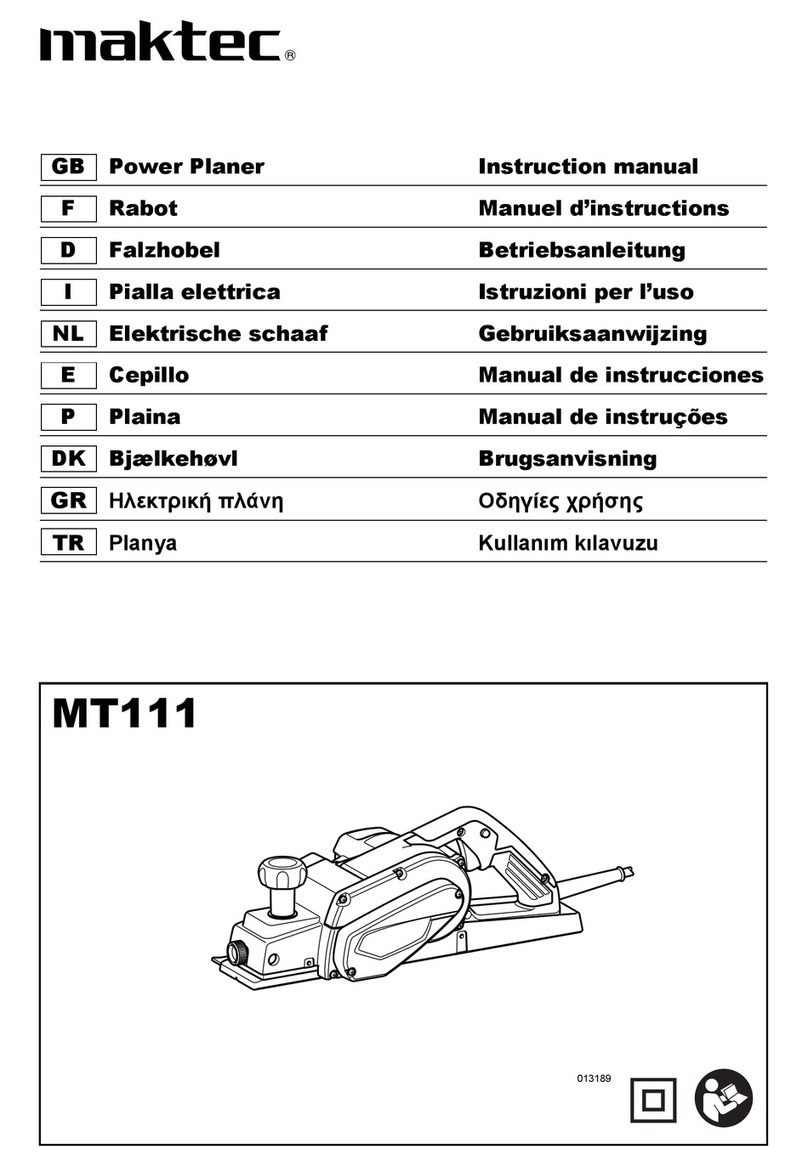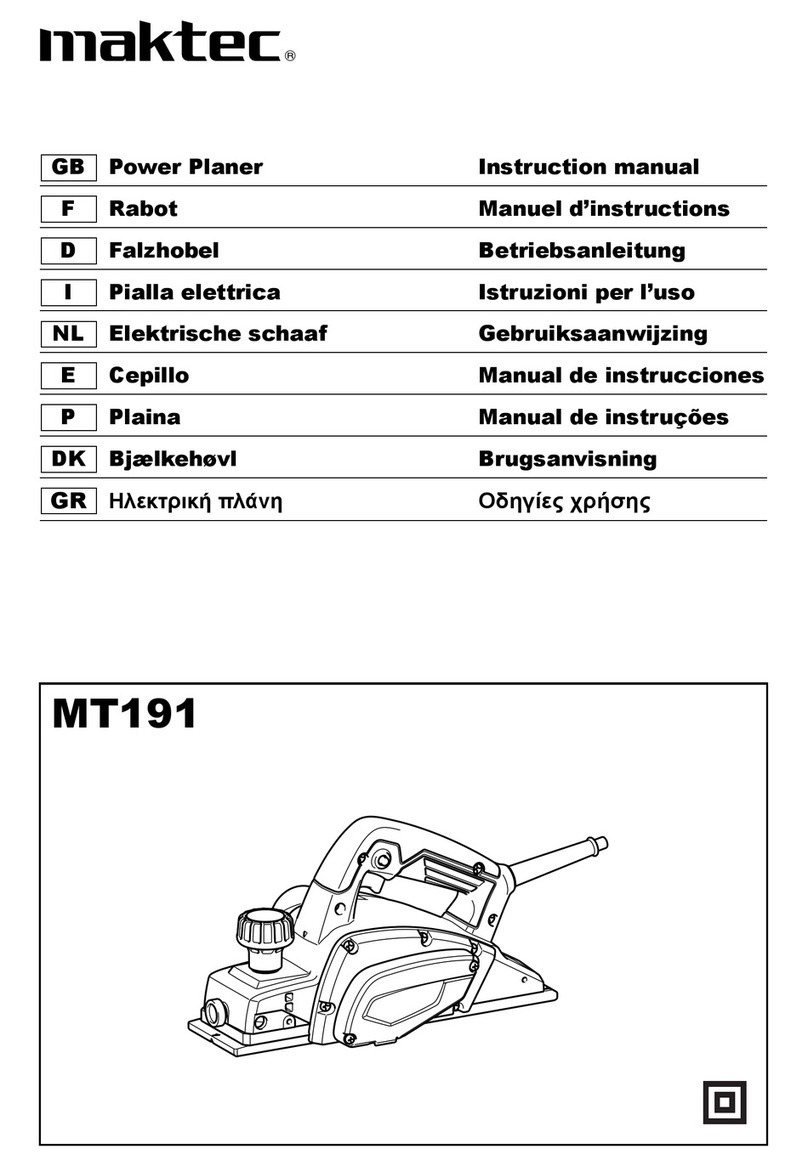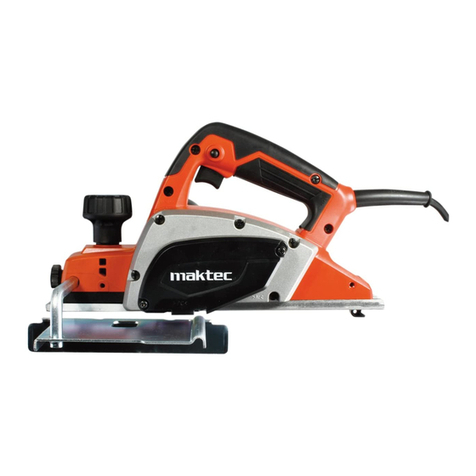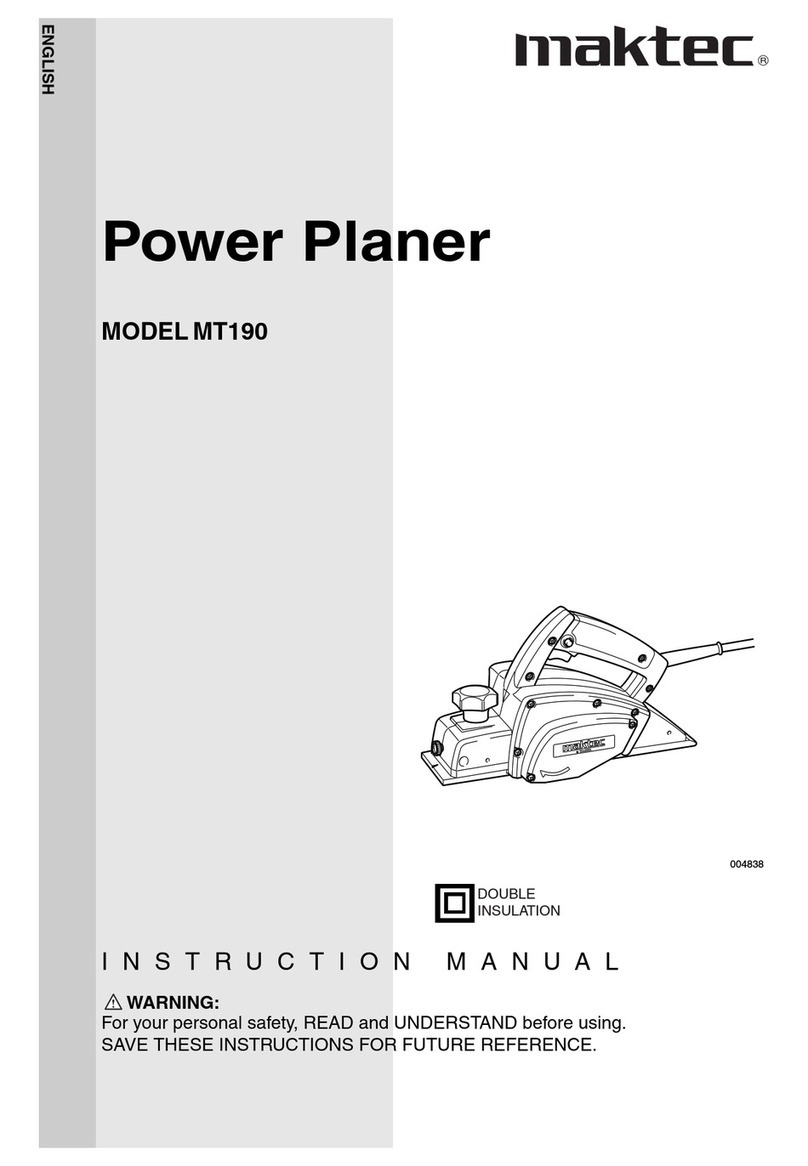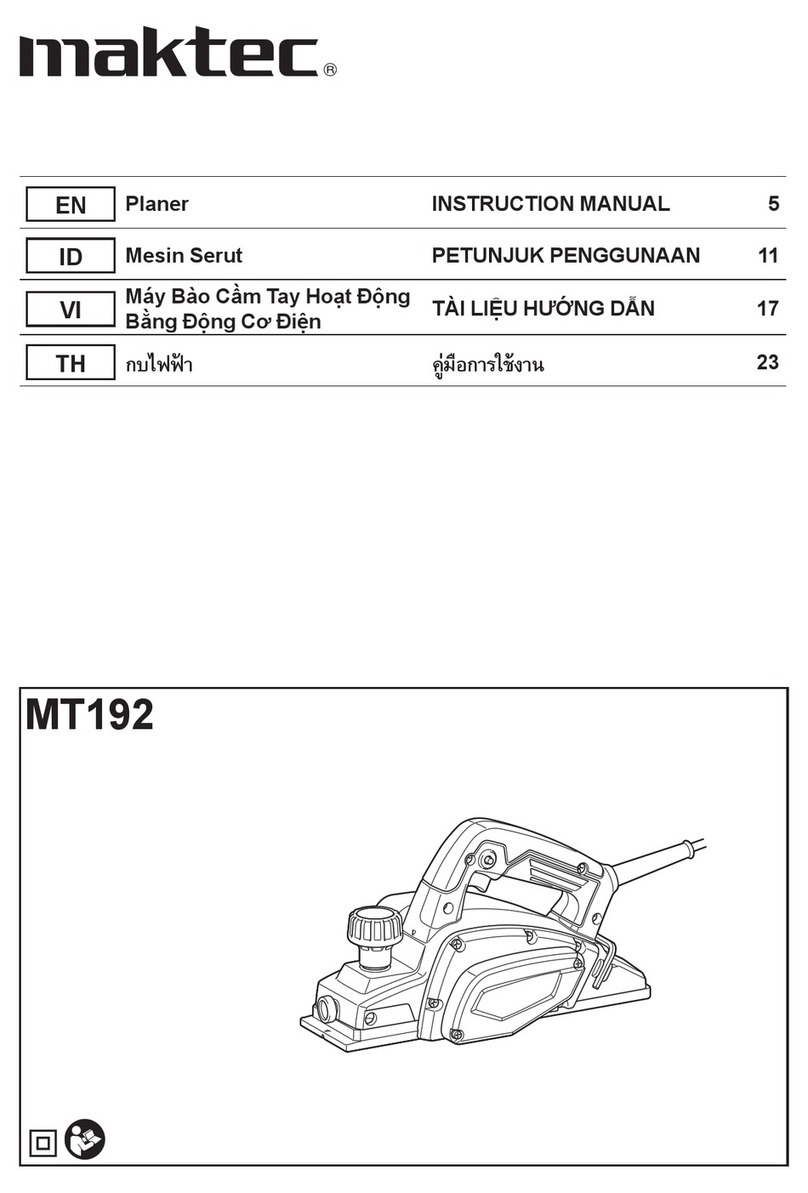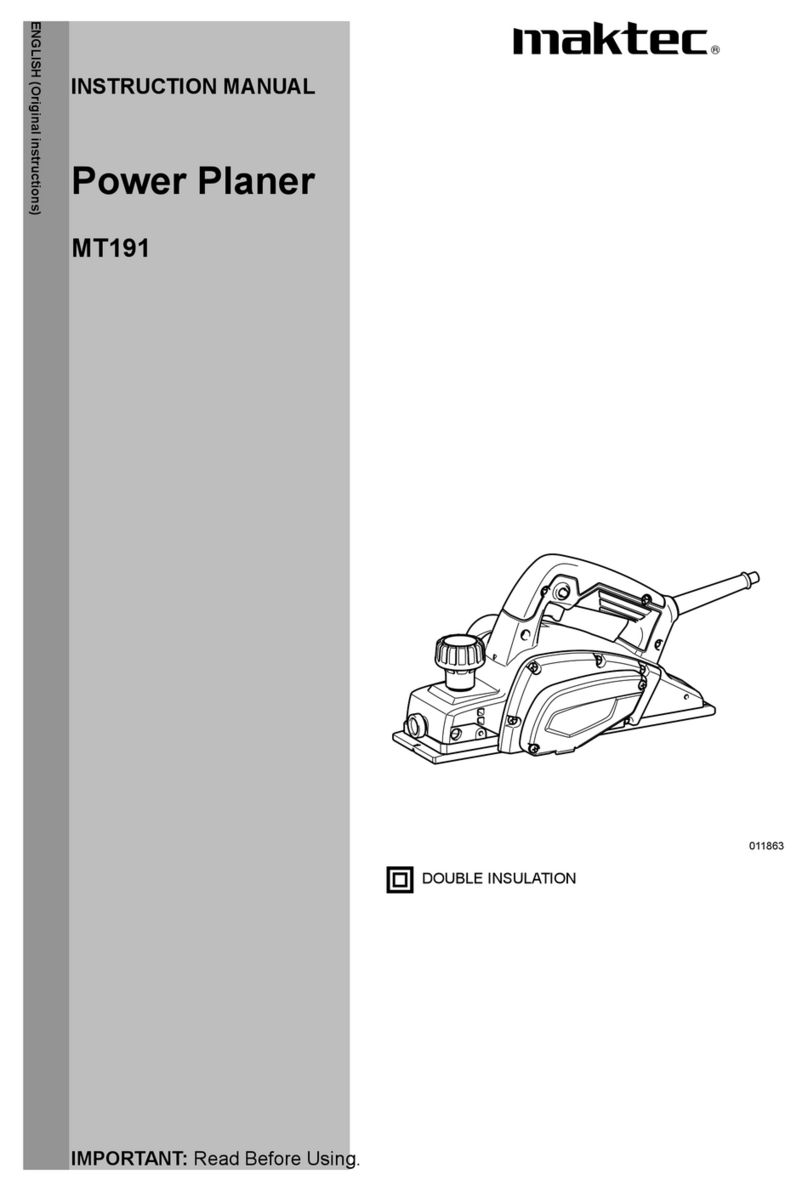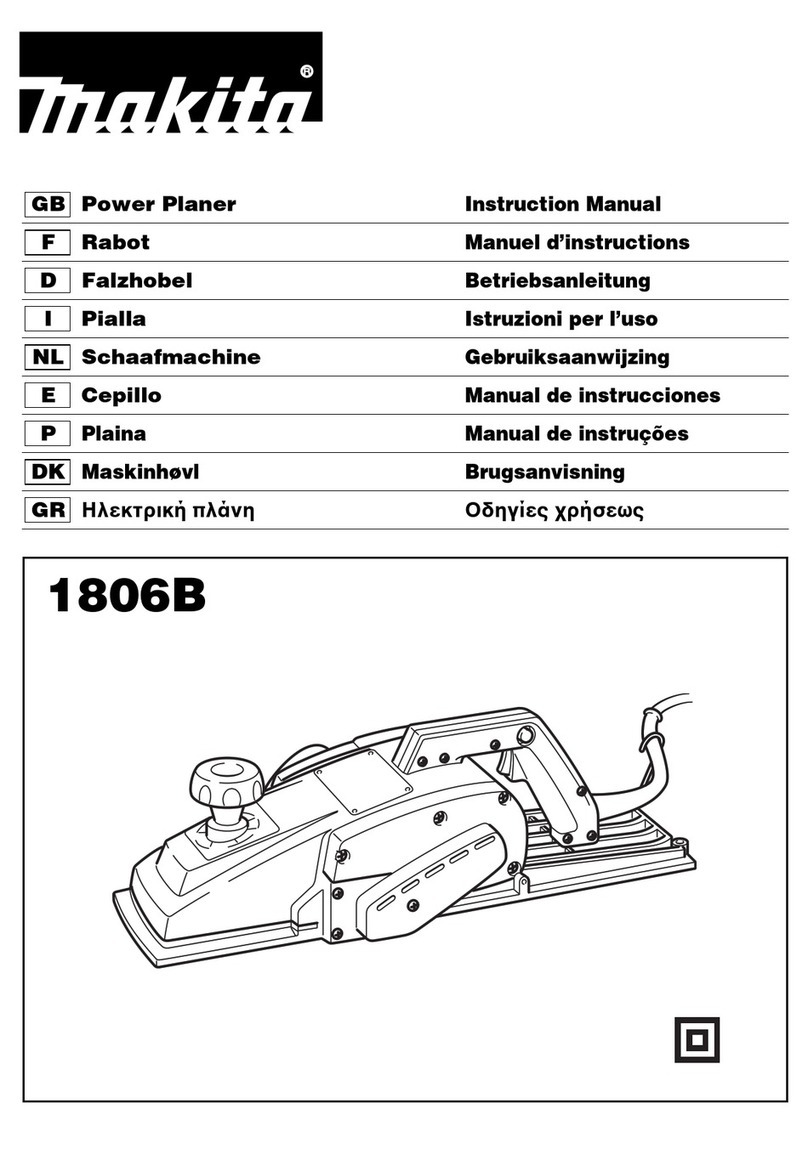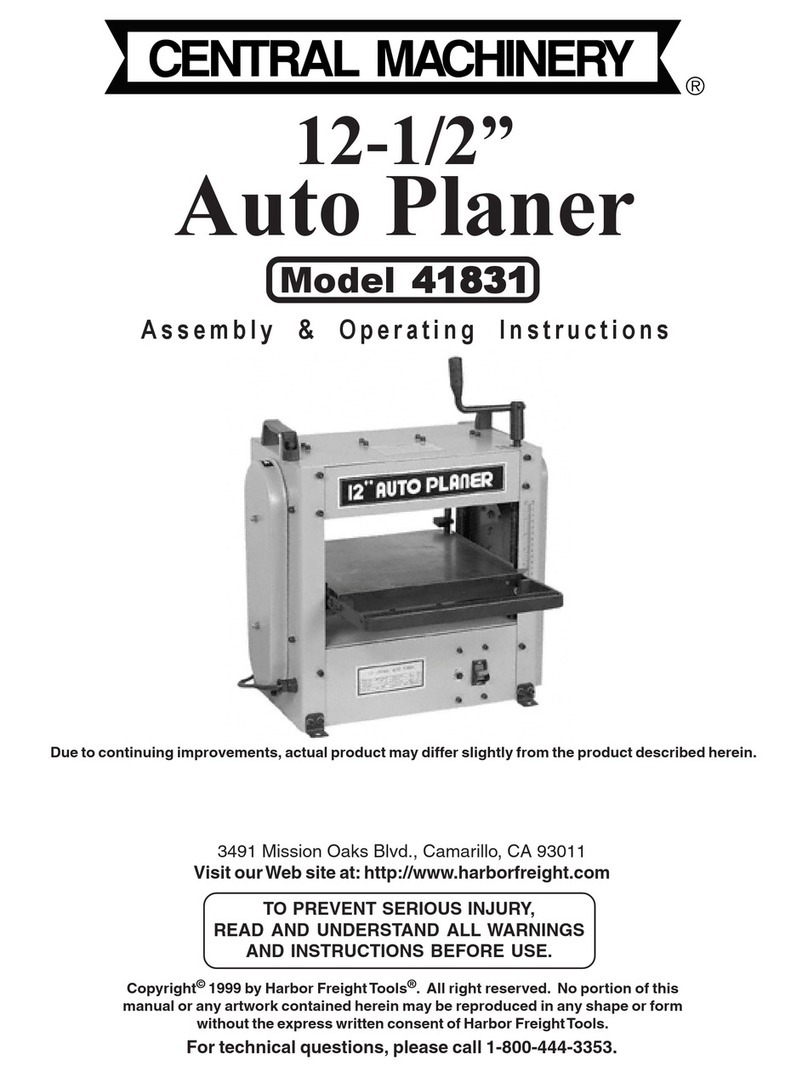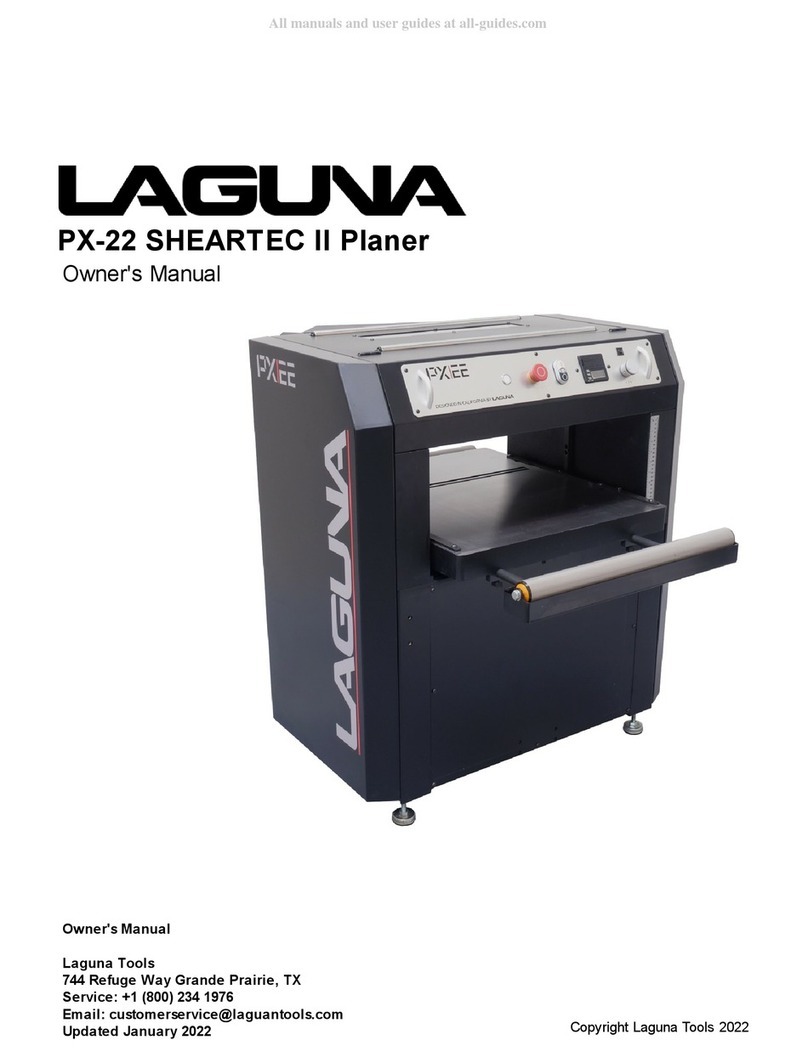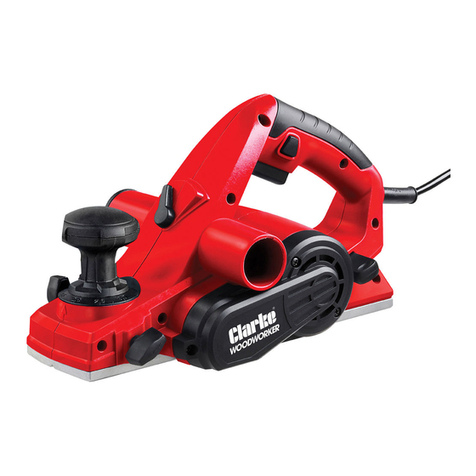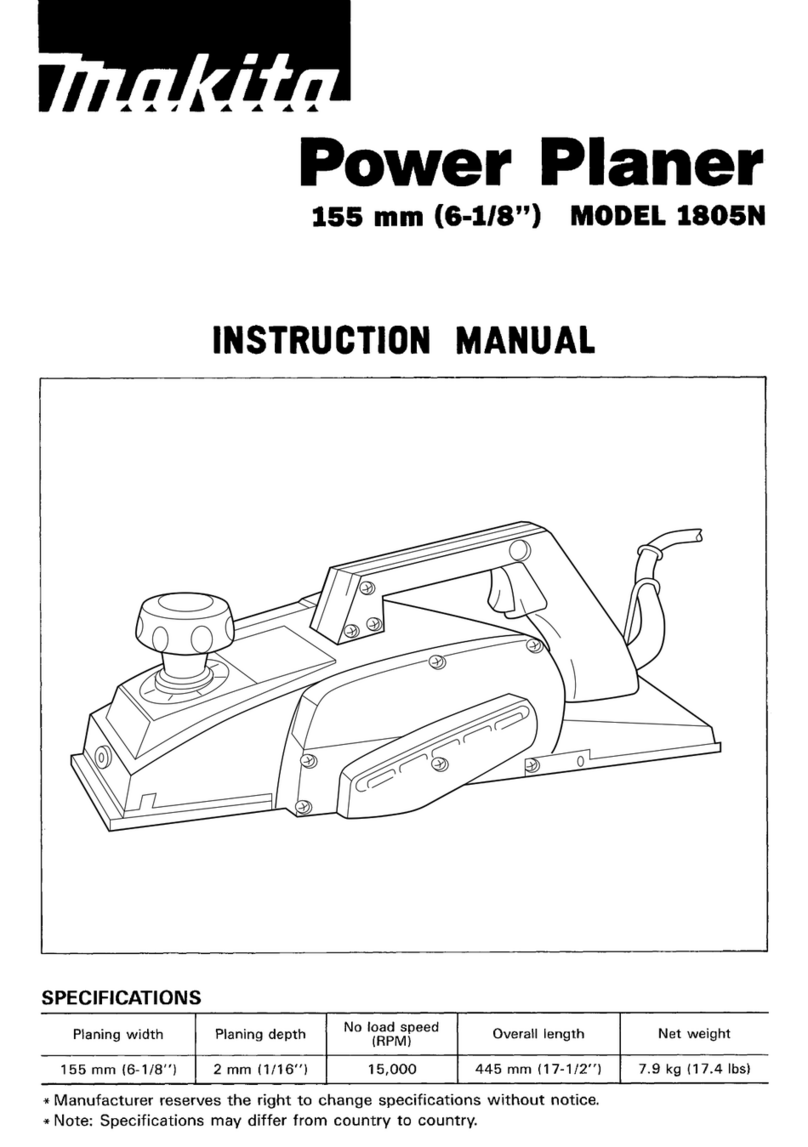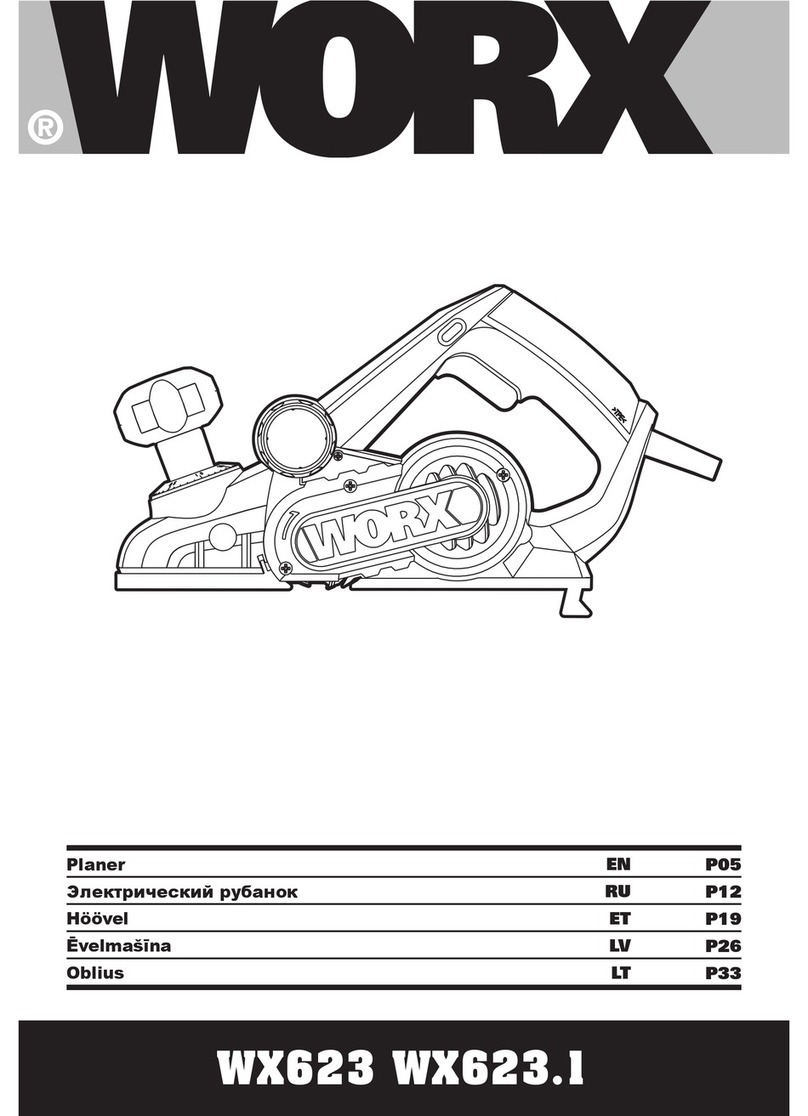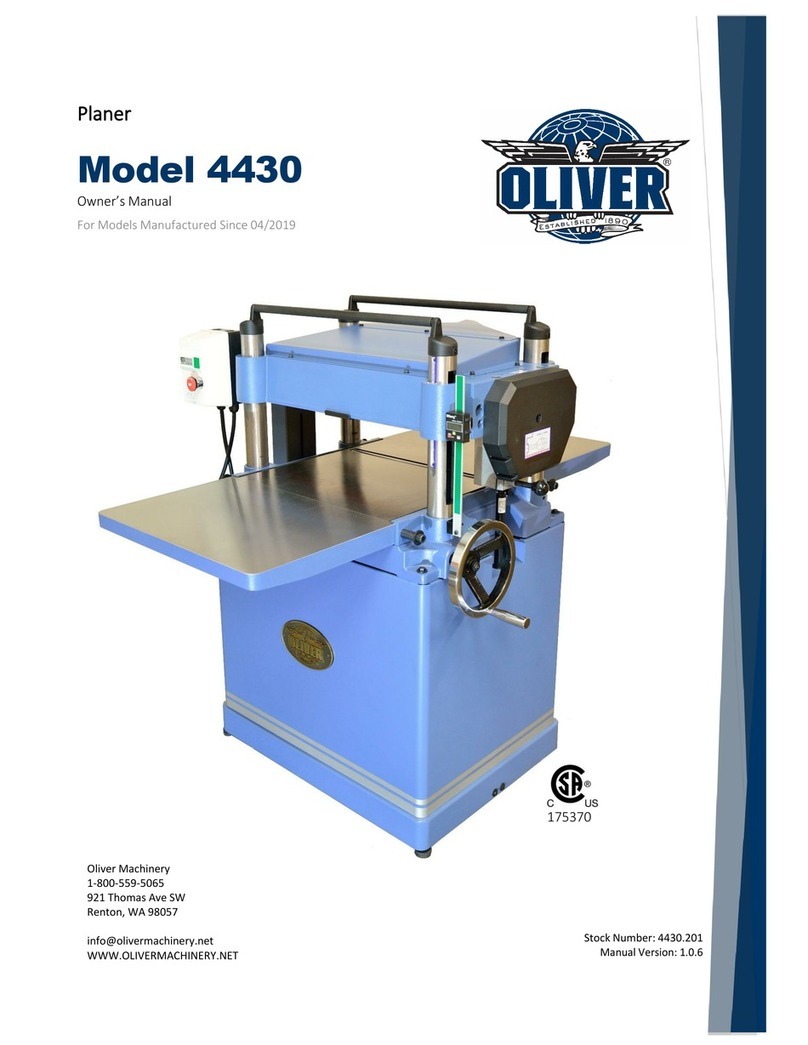Maktec MT111 User manual

GB Power Planer Instruction manual
ID Mesin Serut Listrik Petunjuk penggunaan
Máy Bào Cầm Tay Hoạt Động
Bằng Động CơĐiện
VI Tài liệu hướng dẫn
TH เครื่องไสไมไฟฟาคูมือการใชงาน
MT111

2
1013190 2013191
3013192 4013185
5002556 6013186
7013312 8013194
1
2
3
54
67
7
8
9
10
11
12
13
9
11
14
15
16
17
18
14
11
19
17
20
21
22
18
16
23
8
23
21
11
7
10
14
24
25

3
9013196 10 002580
11 013314 12 013313
13 013198 14 003634
15 013203 16 002588
26
27 3
28
13
29
14
30
31
32

4
17 004952 18 004953
33
34
35
37
36

5
ENGLISH
Explanation of general view
SPECIFICATIONS
• Due to our continuing program of research and development, the specifications herein are subject to change without
notice.
• Specifications may differ from country to country.
• The weight may differ depending on the attachment(s). The lightest and heaviest combination, according to
EPTA-Procedure 01/2014, are shown in the table.
END201-7
Symbols
The followings show the symbols used for the equipment.
Be sure that you understand their meaning before use.
.... Read instruction manual.
.............. DOUBLE INSULATION
ENE001-1
Intended use
The tool is intended for planing wood.
ENF002-2
Power supply
The tool should be connected only to a power supply of
the same voltage as indicated on the nameplate, and can
only be operated on single-phase AC supply. They are
double-insulated and can, therefore, also be used from
sockets without earth wire.
GEA012-2
General power tool safety
warnings
WARNING: Read all safety warnings, instructions,
illustrations and specifications provided with this
power tool. Failure to follow all instructions listed below
may result in electric shock, fire and/or serious injury.
Save all warnings and
instructions for future reference.
The term “power tool” in the warnings refers to your
mains-operated (corded) power tool or battery-operated
(cordless) power tool.
Work area safety
1. Keep work area clean and well lit. Cluttered or dark
areas invite accidents.
2. Do not operate power tools in explosive
atmospheres, such as in the presence of
flammable liquids, gases or dust. Power tools
create sparks which may ignite the dust or fumes.
1. Pointer
2. Cutting depth indication
3. Knob
4. Lock button / Lock-off button
5. Switch trigger
6. Socket wrench
7. Bolts
8. Drum
9. Planer blade
10. Drum plate
11. Adjusting plate
12. Inside edge of gauge plate
13. Blade edge
14. Screw(s)
15. Heel
16. Back side of gauge base
17. Gauge plate
18. Gauge base
19. Planer blade locating lugs
20. Heel of adjusting plate
21. Set plate
22. Inside flank of gauge plate
23. Mini planer blade
24. Groove of drum
25. Vacuum cleaner
26. Start
27. End
28. Handle
29. Cutting line
30. Edge fence
31. Align the “V” groove with the edge
of the workpiece.
32. Sharpening holder
33. Wing nut
34. Blade (A)
35. Blade (B)
36. Side (D)
37. Side (C)
Model MT111
Planing width 82 mm
Planing depth 3 mm
Shiplapping depth 20 mm
No load speed (min-1) 18,000
Overall length 390 mm
Net weight 4.5 - 4.6 kg
Safety class /II

6
3. Keep children and bystanders away while
operating a power tool. Distractions can cause you
to lose control.
Electrical Safety
1. Power tool plugs must match the outlet. Never
modify the plug in any way. Do not use any
adapter plugs with earthed (grounded) power
tools. Unmodified plugs and matching outlets will
reduce risk of electric shock.
2. Avoid body contact with earthed or grounded
surfaces, such as pipes, radiators, ranges and
refrigerators. There is an increased risk of electric
shock if your body is earthed or grounded.
3. Do not expose power tools to rain or wet
conditions. Water entering a power tool will increase
the risk of electric shock.
4. Do not abuse the cord. Never use the cord for
carrying, pulling or unplugging the power tool.
Keep cord away from heat, oil, sharp edges or
moving parts. Damaged or entangled cords increase
the risk of electric shock.
5. When operating a power tool outdoors, use an
extension cord suitable for outdoor use. Use of a
cord suitable for outdoor use reduces the risk of
electric shock.
6. If operating a power tool in a damp location is
unavoidable, use a residual current device (RCD)
protected supply. Use of an RCD reduces the risk of
electric shock.
7. Use of power supply via an RCD with a rated
residual current of 30 mA or less is always
recommended.
8. Power tools can produce electromagnetic fields
(EMF) that are not harmful to the user. However,
users of pacemakers and other similar medical
devices should contact the maker of their device and/
or doctor for advice before operating this power tool.
9. Do not touch the power plug with wet hands.
10. If the cord is damaged, have it replaced by the
manufacturer or his agent in order to avoid a
safety hazard.
Personal Safety
1. Stay alert, watch what you are doing and use
common sense when operating a power tool. Do
not use a power tool while you are tired or under
the influence of drugs, alcohol or medication. A
moment of inattention while operating power tools
may result in serious personal injury.
2. Use personal protective equipment. Always wear
eye protection. Protective equipment such as a dust
mask, non-skid safety shoes, hard hat or hearing
protection used for appropriate conditions will reduce
personal injuries.
3. Prevent unintentional starting. Ensure the switch
is in the off-position before connecting to power
source and/or battery pack, picking up or carrying
the tool. Carrying power tools with your finger on the
switch or energising power tools that have the switch
on invites accidents.
4. Remove any adjusting key or wrench before
turning the power tool on. A wrench or a key left
attached to a rotating part of the power tool may result
in personal injury.
5. Do not overreach. Keep proper footing and
balance at all times. This enables better control of
the power tool in unexpected situations.
6. Dress properly. Do not wear loose clothing or
jewellery. Keep your hair and clothing away from
moving parts. Loose clothes, jewellery or long hair
can be caught in moving parts.
7. If devices are provided for the connection of dust
extraction and collection facilities, ensure these
are connected and properly used. Use of dust
collection can reduce dust-related hazards.
8. Do not let familiarity gained from frequent use of
tools allow you to become complacent and ignore
tool safety principles. A careless action can cause
severe injury within a fraction of a second.
9. Always wear protective goggles to protect your
eyes from injury when using power tools. The
goggles must comply with ANSI Z87.1 in the USA,
EN 166 in Europe, or AS/NZS 1336 in Australia/
New Zealand. In Australia/New Zealand, it is
legally required to wear a face shield to protect
your face, too.
It is an employer's responsibility to enforce the
use of appropriate safety protective equipments
by the tool operators and by other persons in the
immediate working area.
Power tool use and care
1. Do not force the power tool. Use the correct power
tool for your application. The correct power tool will
do the job better and safer at the rate for which it was
designed.
2. Do not use the power tool if the switch does not
turn it on and off. Any power tool that cannot be
controlled with the switch is dangerous and must be
repaired.
3. Disconnect the plug from the power source and/or
remove the battery pack, if detachable, from the
power tool before making any adjustments,
changing accessories, or storing power tools.
Such preventive safety measures reduce the risk of
starting the power tool accidentally.
4. Store idle power tools out of the reach of children
and do not allow persons unfamiliar with the
power tool or these instructions to operate the
power tool. Power tools are dangerous in the hands
of untrained users.

7
5. Maintain power tools and accessories. Check for
misalignment or binding of moving parts,
breakage of parts and any other condition that
may affect the power tool’s operation. If damaged,
have the power tool repaired before use. Many
accidents are caused by poorly maintained power
tools.
6. Keep cutting tools sharp and clean. Properly
maintained cutting tools with sharp cutting edges are
less likely to bind and are easier to control.
7. Use the power tool, accessories and tool bits etc.
in accordance with these instructions, taking into
account the working conditions and the work to
be performed. Use of the power tool for operations
different from those intended could result in a
hazardous situation.
8. Keep handles and grasping surfaces dry, clean
and free from oil and grease. Slippery handles and
grasping surfaces do not allow for safe handling and
control of the tool in unexpected situations.
9. When using the tool, do not wear cloth work
gloves which may be entangled. The entanglement
of cloth work gloves in the moving parts may result in
personal injury.
Service
1. Have your power tool serviced by a qualified
repair person using only identical replacement
parts. This will ensure that the safety of the power tool
is maintained.
2. Follow instruction for lubricating and changing
accessories.
GEB167-1
Planer Safety Warnings
1. Wait for the cutter to stop before setting the tool
down. An exposed rotating cutter may engage the
surface leading to possible loss of control and serious
injury.
2. Hold the power tool by insulated gripping
surfaces, because the cutter may contact its own
cord. Cutting a “live” wire may make exposed metal
parts of the power tool “live” and could give the
operator an electric shock.
3. Use clamps or another practical way to secure and
support the workpiece to a stable platform. Holding
the workpiece by your hand or against the body leaves
it unstable and may lead to loss of control.
4. Rags, cloth, cord, string and the like should never
be left around the work area.
5. Avoid cutting nails. Inspect for and remove all
nails from the workpiece before operation.
6. Use only sharp blades. Handle the blades very
carefully.
7. Be sure the blade installation bolts are securely
tightened before operation.
8. Hold the tool firmly with both hands.
9. Keep hands away from rotating parts.
10. Before using the tool on an actual workpiece, let it
run for a while. Watch for vibration or wobbling
that could indicate poor installation or a poorly
balanced blade.
11. Make sure the blade is not contacting the
workpiece before the switch is turned on.
12. Wait until the blade attains full speed before
cutting.
13. Always switch off and wait for the blades to come
to a complete stop before any adjusting.
14. Never stick your finger into the chip chute. Chute
may jam when cutting damp wood. Clean out
chips with a stick.
15. Do not leave the tool running. Operate the tool
only when hand-held.
16. Always change both blades or covers on the
drum, otherwise the resulting imbalance will
cause vibration and shorten tool life.
17. Use only Makita blades specified in this manual.
18. Always use the correct dust mask/respirator for
the material and application you are working with.
SAVE THESE INSTRUCTIONS.
WARNING:
DO NOT let comfort or familiarity with product (gained
from repeated use) replace strict adherence to safety
rules for the subject product.
MISUSE or failure to follow the safety rules stated in
this instruction manual may cause serious personal
injury.
FUNCTIONAL DESCRIPTION
CAUTION:
• Always be sure that the tool is switched off and
unplugged before adjusting or checking function on the
tool.
Adjusting depth of cut (Fig. 1)
To adjust the depth of cut, turn the front knob until the
pointer indicates desired depth.
Switch action (Fig. 2)
CAUTION:
• Before plugging in the tool, always check to see that
the switch trigger actuates properly and returns to the
“OFF” position when released.
For tool with lock button
To start the tool, simply pull the switch trigger. Release the
switch trigger to stop.
For continuous operation, pull the switch trigger and then
push in the lock button, and release the switch trigger.
To stop the tool from the locked position, pull the switch
trigger fully, then release it.
For tool with lock-off button
To prevent the switch trigger from being accidentally
pulled, a lock-off button is provided. To start the tool, press
the lock-off button and pull the switch trigger. Release the
switch trigger to stop.
Do not pull the switch trigger hard without depressing the
lock-off button. It may cause switch breakage.
ASSEMBLY
CAUTION:
• Always be sure that the tool is switched off and
unplugged before carrying out any work on the tool.

8
Removing or installing planer blades
CAUTION:
• Tighten the blade installation bolts carefully when
attaching the blades to the tool. A loose installation bolt
can be dangerous. Always check to see they are
tightened securely.
• Handle the blades very carefully. Use gloves or rags to
protect your fingers or hands when removing or
installing the blades.
• Use only the Makita wrench provided to remove or
install the blades. Failure to do so may result in
overtightening or insufficient tightening of the
installation bolts. This could cause an injury.
For tools with conventional planer blades (Fig. 3,
Fig. 4 & Fig. 5)
To remove the blades on the drum, unscrew the three
installation bolts with the socket wrench. The drum plate
comes off together with the blades.
To install the blades, first clean out all chips or foreign
matter adhering to the drum or blades. Use blades of the
same dimensions and weight, or drum oscillation/vibration
will result, causing poor planing action and, eventually,
tool breakdown.
Place the blade on the gauge base so that the blade edge
is perfectly flush with the inside edge of the gauge plate.
Place the adjusting plate on the blade, then simply press
in the heel of the adjusting plate flush with the back side of
the gauge base and tighten two screws on the adjusting
plate. Now slip the heel of the adjusting plate into the
drum groove, then fit the drum cover on it. Tighten the
three installation bolts evenly and alternately with the
socket wrench.
For tool with mini planer blades (Fig. 3, Fig. 6 & Fig. 7)
1. Remove the existing blade, if the tool has been in use,
carefully clean the drum surfaces and the drum cover.
To remove the blades on the drum, unscrew the three
installation bolts with the socket wrench. The drum
cover comes off together with the blades.
2. To install the blades, loosely attach the adjusting plate
to the set plate with the pan head screws and set the
mini planer blade on the gauge base so that the
cutting edge of the blade is perfectly flush with the
inside flank of the gauge plate.
3. Set the adjusting plate/set plate on the gauge base so
that the planer blade locating lugs on the set plate rest
in the mini planer blade groove, then press in the heel
of the adjusting plate flush with the back side of the
gauge base and tighten the pan head screws.
4. It is important that the blade sits flush with the inside
flank of the gauge plate, the planer blade locating lugs
sit in the blade groove and the heel of the adjusting
plate is flush with the back side of the gauge base.
Check this alignment carefully to ensure uniform
cutting.
5. Slip the heel of the adjusting plate into the groove of
the drum.
6. Set the drum cover over the adjusting plate/set plate
and screw in the three hex flange head bolts so that a
gap exists between the drum and the set plate to slide
the mini planer blade into position. The blade will be
positioned by the planer blade locating lugs on the set
plate.
7. The blade's lengthwise adjustment will need to be
manually positioned so that the blade ends are clear
and equidistant from the housing on one side and the
metal bracket on the other.
8. Tighten the three hex flange head bolts (with the
socket wrench provided) and rotate the drum to check
clearances between the blade ends and the tool body.
9. Check the three hex flange head bolts for final
tightness.
10. Repeat procedures 1 - 9 for other blade.

9
For the correct planer blade setting
Your planing surface will end up rough and uneven, unless the blade is set properly and securely. The blade must be
mounted so that the cutting edge is absolutely level, that is, parallel to the surface of the rear base.
Below are some examples of proper and improper .
Connecting a vacuum cleaner (Fig. 8)
NOTE:
• In some countries, the nozzle may not be included in
the tool package as standard accessory.
For tool with nozzle
Connect a hose of the vacuum cleaner to the nozzle.
For tool without nozzle
1. Remove the chip cover from the tool.
2. Install the nozzle on the tool using the screws.
3. Connect a hose of the vacuum cleaner to the nozzle.
Nozzle cleaning
Clean the nozzle regularly.
Use a compressed air to clean the clogged nozzle.
OPERATION
WARNING: To reduce the risk of injury to persons,
do not operate without nozzle or chip cover in place.
CAUTION:
• Hold the tool firmly with one hand on the knob and the
other hand on the switch handle when performing the
tool.
Planing operation (Fig. 9)
First, rest the tool front base flat upon the workpiece
surface without the blades making any contact. Switch on
and wait until the blades attain full speed. Then move the
tool gently forward. Apply pressure on the front of tool at
the start of planing, and at the back at the end of planing.
Planing will be easier if you incline the workpiece in
stationary fashion, so that you can plane somewhat
downhill.
The speed and depth of cut determine the kind of finish.
The power planer keeps cutting at a speed that will not
result in jamming by chips. For rough cutting, the depth of
cut can be increased, while for a good finish you should
reduce the depth of cut and advance the tool more slowly.
Shiplapping (Rabbeting) (Optional
accessory)
To make a stepped cut as shown in the figure, use the
edge fence (guide rule). (Fig. 10)
CAUTION:
• The blade edge should be made to protrude outside
slightly (0.3 mm - 0.6 mm). Otherwise, nicks and
generally poor shiplapping results.
Draw a cutting line on the workpiece. Insert the edge
fence into the hole in the front of the tool. Align the blade
edge with the cutting line. (Fig. 11 & Fig. 12)
Adjust the edge fence until it comes in contact with the
side of the workpiece, then secure it by tightening the
screw. (Fig. 13)
When planing, move the tool with the edge fence flush
with the side of the workpiece. Otherwise uneven planing
may result.
Maximum shiplapping (rabbeting) depth is 20 mm.
You may wish to add to the length of the fence by
attaching an extra piece of wood. Convenient holes are
provided in the fence for this purpose.
(A) Front base (Movable shoe)
(B) Rear base (Stationary shoe)
Correct setting
Nicks in surface
Gouging at start
Gouging at end
Although this side view cannot show it,
the edges of the blades run perfectly
parallel to the rear base surface.
Cause: One or both blades fails to have
edge parallel to rear base line.
Cause: One or both blade edges fails to
protrude enough in relation to
rear base line.
Cause: One or both blade edges
protrudes too far in relation to
rear base line.
EN0004-1
(A) (B)
(B)
(A) (B)
(A)

10
Chamfering (Fig. 14 & Fig. 15)
To make a chamfering cut as shown in the figure, align the
“V” groove in the front base with the edge of the
workpiece and plane it.
MAINTENANCE
CAUTION:
• Always be sure that the tool is switched off and
unplugged before attempting to perform inspection or
maintenance.
• Never use gasoline, benzine, thinner, alcohol or the
like. Discoloration, deformation or cracks may result.
To maintain product SAFETY and RELIABILITY, repairs,
carbon brush inspection and replacement, any other
maintenance or adjustment should be performed by
Makita Authorized or Factory Service Centers, always
using Makita replacement parts.
Sharpening the planer blades (only for
tool with conventional blades)
Always keep your blades sharp for the best performance
possible. Use the sharpening holder to remove nicks and
produce a fine edge. (Fig. 16)
First, loosen the two wing nuts on the holder and insert
the blades (A) and (B), so that they contact the sides (C)
and (D). Then tighten the wing nuts. (Fig. 17)
Immerse the dressing stone in water for 2 or 3 minutes
before sharpening. Hold the holder so that the both blades
contact the dressing stone for simultaneous sharpening at
the same angle. (Fig. 18)

11
BAHASA INDONESIA
Penjelasan tampilan keseluruhan
SPESIFIKASI
• Karena kesinambungan program penelitian dan pengembangan kami, spesifikasi yang disebutkan di sini dapat
berubah tanpa pemberitahuan.
• Spesifikasi dapat berbeda dari satu negara ke negara lainnya.
• Berat alat mungkin berbeda tergantung perangkat tambahan yang dipasang. Kombinasi alat terberat dan teringan,
sesuai Prosedur EPTA 01/2014, ditunjukkan pada tabel.
END201-7
Simbol
Berikut ini adalah simbol-simbol yang digunakan pada
peralatan ini.
Pastikan Anda mengerti makna masing-masing simbol
sebelum menggunakan alat.
..... Baca petunjuk penggunaan.
.............. ISOLASI GANDA
ENE001-1
Penggunaan
Mesin ini digunakan untuk menyerut kayu.
ENF002-2
Pasokan daya
Mesin harus terhubung dengan pasokan daya listrik yang
bervoltase sama dengan yang tertera pada pelat nama,
dan hanya dapat dijalankan dengan listrik AC fase
tunggal. Mesin diisolasi ganda dan oleh sebab itu dapat
dihubungkan dengan soket tanpa arde.
GEA012-2
Peringatan keselamatan umum
mesin listrik
PERINGATAN: Bacalah semua peringatan
keselamatan, petunjuk, ilustrasi dan spesifikasi yang
disertakan bersama mesin listrik ini. Kelalaian untuk
mematuhi semua petunjuk yang tercantum di bawah ini
dapat menyebabkan sengatan listrik, kebakaran dan/atau
cedera serius.
Simpanlah semua peringatan dan
petunjuk untuk acuan di masa
depan.
Istilah “mesin listrik” dalam semua peringatan mengacu
pada mesin listrik yang dijalankan dengan sumber listrik
jala-jala (berkabel) atau baterai (tanpa kabel).
Keselamatan tempat kerja
1. Jaga tempat kerja selalu bersih dan
berpenerangan cukup. Tempat kerja yang
berantakan dan gelap mengundang kecelakaan.
1. Penunjuk
2. Indikator kedalaman pemotongan
3. Knop
4. Tombol kunci / Tombol buka kunci
5. Saklar pemicu
6. Kunci sok
7. Baut
8. Teromol
9. Mata pisau serut
10. Pelat teromol
11. Pelat penyetel
12. Tepi dalam pelat pengukur
13. Tepi mata pisau
14. Sekrup
15. Tumit
16. Sisi belakang dudukan pengukur
17. Pelat pengukur
18. Dudukan pengukur
19. Tonjolan penepat mata pisau
serut
20. Tumit pelat penyetel
21. Pelat pengatur
22. Sayap dalam pelat pengukur
23. Mata pisau serut mini
24. Alur teromol
25. Pengisap debu
26. Awal
27. Akhir
28. Pegangan
29. Garis pemotongan
30. Pembatas tepi
31. Sejajarkan alur “V” dengan tepi
benda kerja.
32. Pemegang mata pisau
33. Mur kupu-kupu
34. Mata pisau (A)
35. Mata pisau (B)
36. Sisi (D)
37. Sisi (C)
Model MT111
Lebar penyerutan 82 mm
Kedalaman penyerutan 3 mm
Kedalaman lidah/celah papan rebat 20 mm
Kecepatan tanpa beban (min-1) 18.000
Panjang keseluruhan 390 mm
Berat bersih 4,5 - 4,6 kg
Kelas keamanan /II

12
2. Jangan gunakan mesin listrik dalam lingkungan
yang mudah meledak, misalnya jika ada cairan,
gas, atau debu yang mudah menyala. Mesin listrik
menimbulkan bunga api yang dapat menyalakan debu
atau uap tersebut.
3. Jauhkan anak-anak dan orang lain saat
menggunakan mesin listrik. Bila perhatian terpecah,
anda dapat kehilangan kendali.
Keamanan Kelistrikan
1. Steker mesin listrik harus cocok dengan
stopkontak. Jangan sekali-kali mengubah steker
dengan cara apa pun. Jangan menggunakan
steker adaptor dengan mesin listrik terbumi
(dibumikan). Steker yang tidak diubah dan
stopkontak yang cocok akan mengurangi risiko
sengatan listrik.
2. Hindari sentuhan tubuh dengan permukaan
terbumi atau yang dibumikan seperti pipa,
radiator, kompor, dan kulkas. Risiko sengatan listrik
bertambah jika tubuh Anda terbumikan atau
dibumikan.
3. Jangan membiarkan mesin listrik kehujanan atau
kebasahan. Air yang masuk ke dalam mesin listrik
akan meningkatkan risiko sengatan listrik.
4. Jangan menyalahgunakan kabel. Jangan sekali-
kali menggunakan kabel untuk membawa,
menarik, atau mencabut mesin listrik dari
stopkontak. Jauhkan kabel dari panas, minyak,
tepian tajam, atau bagian yang bergerak. Kabel
yang rusak atau kusut memperbesar risiko sengatan
listrik.
5. Bila menggunakan mesin listrik di luar ruangan,
gunakan kabel ekstensi yang sesuai untuk
penggunaan di luar ruangan. Penggunaan kabel
yang sesuai untuk penggunaan luar ruangan
mengurangi risiko sengatan listrik.
6. Jika mengoperasikan mesin listrik di lokasi
lembap tidak terhindarkan, gunakan pasokan daya
yang dilindungi peranti imbasan arus (residual
current device - RCD). Penggunaan RCD
mengurangi risiko sengatan listrik.
7. Penggunaan pasokan daya melalui RCD dengan
kapasitas arus sisa 30 mA atau kurang selalu
dianjurkan.
8. Mesin listrik dapat menghasilkan medan magnet
(EMF) yang tidak berbahaya bagi pengguna.
Namun, pengguna alat pacu jantung atau peralatan
medis sejenisnya harus berkonsultasi dengan
produsen peralatan tersebut dan/atau dokter mereka
sebelum mengoperasikan mesin listrik ini.
9. Jangan menyentuh colokan daya dengan tangan
basah.
10. Jika kabel rusak, penggantian harus dilakukan
oleh produsen atau agennya untuk menghindari
bahaya keselamatan.
Keselamatan Diri
1. Jaga kewaspadaan, perhatikan pekerjaan Anda
dan gunakan akal sehat bila menggunakan mesin
listrik. Jangan menggunakan mesin listrik saat
Anda lelah atau di bawah pengaruh obat bius,
alkohol, atau obat. Sekejap saja lalai saat
menggunakan mesin listrik dapat menyebabkan
cedera badan serius.
2. Gunakan alat pelindung diri. Selalu gunakan
pelindung mata. Peralatan pelindung seperti masker
debu, sepatu pengaman anti-selip, helm pengaman,
atau pelindung telinga yang digunakan untuk kondisi
yang sesuai akan mengurangi risiko cedera badan.
3. Cegah penyalaan yang tidak disengaja. Pastikan
bahwa sakelar berada dalam posisi mati (off)
sebelum menghubungkan mesin ke sumber daya
dan/atau paket baterai, atau mengangkat atau
membawanya. Membawa mesin listrik dengan jari
Anda pada sakelarnya atau mengalirkan listrik pada
mesin listrik yang sakelarnya hidup (on) akan
mengundang kecelakaan.
4. Lepaskan kunci-kunci penyetel sebelum
menghidupkan mesin listrik. Kunci-kunci yang
masih terpasang pada bagian mesin listrik yang
berputar dapat menyebabkan cedera.
5. Jangan meraih terlalu jauh. Jagalah pijakan dan
keseimbangan sepanjang waktu. Hal ini
memungkinkan kendali yang lebih baik atas mesin
listrik dalam situasi yang tidak diharapkan.
6. Kenakan pakaian yang memadai. Jangan memakai
pakaian yang longgar atau perhiasan. Jaga jarak
antara rambut dan pakaian Anda dengan
komponen mesin yang bergerak. Pakaian yang
longgar, perhiasan, atau rambut yang panjang dapat
tersangkut pada komponen yang bergerak.
7. Jika tersedia fasilitas untuk menghisap dan
mengumpulkan debu, pastikan fasilitas tersebut
terhubung listrik dan digunakan dengan baik.
Penggunaan pembersih debu dapat mengurangi
bahaya yang terkait dengan debu.
8. Jangan sampai Anda lengah dan mengabaikan
prinsip keselamatan mesin ini hanya karena sudah
sering mengoperasikannya dan sudah merasa
terbiasa. Tindakan yang lalai dapat menyebabkan
cedera berat dalam sepersekian detik saja.
9. Selalu kenakan kacamata pelindung untuk
melindungi mata dari cedera saat menggunakan
mesin listrik. Kacamata harus sesuai dengan ANSI
Z87.1 di Amerika Serikat, EN 166 di Eropa, atau
AS/NZS 1336 di Australia/Selandia Baru. Di
Australia/Selandia Baru, secara hukum Anda juga
diwajibkan mengenakan pelindung wajah untuk
melindungi wajah Anda.
Menjadi tanggung jawab atasan untuk
menerapkan penggunaan alat pelindung
keselamatan yang tepat bagi operator mesin dan
orang lain yang berada di area kerja saat itu.

13
Penggunaan dan pemeliharaan mesin listrik
1. Jangan memaksa mesin listrik. Gunakan mesin
listrik yang tepat untuk keperluan Anda. Mesin
listrik yang tepat akan menuntaskan pekerjaan
dengan lebih baik dan aman pada kecepatan sesuai
rancangannya.
2. Jangan gunakan mesin listrik jika sakelar tidak
dapat menyalakan dan mematikannya. Mesin listrik
yang tidak dapat dikendalikan dengan sakelarnya
adalah berbahaya dan harus diperbaiki.
3. Cabut steker dari sumber listrik dan/atau lepas
paket baterai, jika dapat dilepas, dari mesin listrik
sebelum melakukan penyetelan apa pun,
mengganti aksesori, atau menyimpan mesin
listrik. Langkah keselamatan preventif tersebut
mengurangi risiko hidupnya mesin secara tak
sengaja.
4. Simpan mesin listrik jauh dari jangkauan anak-
anak dan jangan biarkan orang yang tidak paham
mengenai mesin listrik tersebut atau petunjuk ini
menggunakan mesin listrik. Mesin listrik sangat
berbahaya di tangan pengguna yang tak terlatih.
5. Rawatlah mesin listrik dan aksesori. Periksa
apakah ada komponen bergerak yang tidak lurus
atau macet, komponen yang pecah, dan kondisi-
kondisi lain yang dapat memengaruhi
pengoperasian mesin listrik. Jika rusak, perbaiki
dahulu mesin listrik sebelum digunakan. Banyak
kecelakaan disebabkan oleh kurangnya pemeliharaan
mesin listrik.
6. Jaga agar mesin pemotong tetap tajam dan bersih.
Mesin pemotong yang terawat baik dengan mata
pemotong yang tajam tidak mudah macet dan lebih
mudah dikendalikan.
7. Gunakan mesin listrik, aksesori, dan mata mesin,
dll. sesuai dengan petunjuk ini, dengan
memperhitungkan kondisi kerja dan jenis
pekerjaan yang dilakukan. Penggunaan mesin listrik
untuk penggunaan yang lain dari peruntukan dapat
menimbulkan situasi berbahaya.
8. Jagalah agar gagang dan permukaan pegangan
tetap kering, bersih, dan bebas dari minyak dan
pelumas. Gagang dan permukaan pegangan yang
licin tidak mendukung keamanan penanganan dan
pengendalian mesin dalam situasi-situasi tak terduga.
9. Ketika menggunakan mesin, jangan
menggunakan sarung tangan kain yang dapat
tersangkut. Sarung tangan kain yang tersangkut
pada komponen bergerak dapat mengakibatkan
cedera pada pengguna.
Servis
1. Berikan mesin listrik untuk diperbaiki hanya
kepada oleh teknisi yang berkualifikasi dengan
menggunakan hanya suku cadang pengganti yang
serupa. Hal ini akan menjamin terjaganya keamanan
mesin listrik.
2. Patuhi petunjuk pelumasan dan penggantian
aksesori.
GEB167-1
Peringatan Keselamatan Mesin
Serut
1. Tunggu sampai pemotong berhenti sebelum
menyetel mesin. Pemotong yang berputar dapat
bersentuhan dengan permukaan, yang bisa
menyebabkan kehilangan kendali dan cedera serius.
2. Pegang mesin listrik pada permukaan genggam
yang terisolasi, karena permukaan pemotong
dapat bersentuhan dengan kabelnya sendiri.
Memotong kawat “hidup” dapat menyebabkan bagian
logam pada mesin teraliri arus listrik dan menyengat
pengguna.
3. Gunakan klem atau cara praktis lainnya untuk
mengikat dan menahan benda kerja pada posisi
yang stabil. Menahan benda kerja dengan tangan
Anda atau berada pada posisi berlawanan dengan
badan membuat benda kerja tidak stabil dan dapat
menyebabkan kehilangan kendali.
4. Lap, kain, kabel, tali dan sejenisnya jangan pernah
dibiarkan berada di sekitar tempat kerja.
5. Hindari memotong paku. Periksa dan buang
semua paku dari benda kerja sebelum
penggunaan.
6. Gunakan hanya mata pisau yang tajam. Tangani
mata pisau dengan sangat hati-hati.
7. Pastikan bahwa baut-baut pengikat mata pisau
benar-benar terpasang dengan kuat sebelum
pengoperasian.
8. Pegang mesin kuat-kuat dengan kedua tangan.
9. Jauhkan tangan dari bagian yang berputar.
10. Sebelum menggunakan mesin pada benda kerja
yang sebenarnya, jalankan mesin sebentar.
Perhatikan akan adanya getaran atau goyangan
yang dapat menunjukkan lemahnya pemasangan
atau mata pisau yang kurang seimbang.
11. Pastikan bahwa mata pisau tidak menyentuh
benda kerja sebelum sakelar dinyalakan.
12. Tunggu sampai mata pisau mencapai kecepatan
penuh sebelum memotong.
13. Selalu matikan dan tunggu sampai mata pisau
benar-benar berhenti sebelum melakukan
penyetelan apapun.
14. Jangan pernah menempelkan jari Anda pada
saluran pembuangan serpihan kayu. Saluran
pembuangan bisa macet ketika memotong kayu
basah. Bersihkan serpihan-serpihan kayu dengan
menggunakan stik.
15. Jangan meninggalkan mesin dalam keadaan
hidup. Jalankan mesin hanya ketika digenggam
dengan tangan.
16. Selalu ganti kedua mata pisau atau tutup-tutup
pada teromol, jika tidak, ketidakseimbangan yang
terjadi akan menyebabkan getaran dan
memperpendek usia pakai mesin.
17. Gunakan hanya mata pisau Makita yang
ditentukan dalam petunjuk ini.
18. Selalu gunakan masker debu/alat pernafasan yang
tepat sesuai bahan dan pekerjaan yang sedang
Anda kerjakan.

14
SIMPAN PETUNJUK INI.
PERINGATAN:
JANGAN biarkan kenyamanan atau terbiasanya Anda
dengan produk (karena penggunaan berulang)
mengurangi kepatuhan yang ketat terhadap aturan
keselamatan untuk produk yang terkait.
PENYALAHGUNAAN atau kelalaian mematuhi kaidah
keselamatan yang tertera dalam petunjuk ini dapat
menyebabkan cedera badan serius.
DESKRIPSI FUNGSI
PERHATIAN:
• Selalu pastikan bahwa mesin dalam keadaan mati dan
steker tercabut sebelum menyetel atau memeriksa
kerja mesin.
Menyetel kedalaman pemotongan (Gb. 1)
Untuk menyetel kedalaman pemotongan, putar knop
depan sampai penunjuk mengarah ke kedalaman yang
diinginkan.
Kerja saklar (Gb. 2)
PERHATIAN:
• Sebelum memasukkan steker, selalu periksa apakah
picu saklar berfungsi dengan baik dan kembali ke
posisi “OFF” saat dilepas.
Untuk mesin dengan tombol kunci
Untuk menjalankan mesin, cukup tarik picu saklarnya.
Lepaskan picu saklar untuk berhenti.
Untuk penggunaan terus-menerus, tarik picu saklar lalu
tekan tombol kunci, dan lepas picu saklar.
Untuk membebaskan posisi terkunci, tarik picu saklar
sampai penuh, lalu lepaskan.
Untuk mesin dengan tombol buka kunci
Untuk mencegah picu saklar tertarik dengan tidak
sengaja, tersedia sebuah tombol buka kunci. Untuk
menjalankan mesin, tekan tombol buka kunci dan tarik
picu saklar. Lepaskan picu saklar untuk berhenti.
Jangan menarik dalam-dalam picu saklar tanpa menekan
tombol buka kunci. Hal tersebut bisa merusak saklar.
PERAKITAN
PERHATIAN:
• Selalu pastikan bahwa mesin dalam keadaan mati dan
steker tercabut sebelum melakukan pekerjaan apapun
pada mesin.
Melepas atau memasang mata pisau serut
PERHATIAN:
• Kencangkan baut-baut pengikat mata pisau dengan
seksama ketika memasang mata pisau pada mesin.
Baut pengikat yang kendur bisa berbahaya. Selalu
periksa apakah baut-baut tersebut terpasang dengan
kuat.
• Tangani mata pisau dengan sangat hati-hati. Gunakan
sarung tangan atau lap untuk melindungi jari-jari atau
tangan Anda ketika melepas dan memasang mata
mesin.
• Gunakan hanya kunci pas Makita yang tersedia ketika
melepas atau memasang mata pisau. Kelalaian dalam
melakukannya dapat mengakibatkan terlalu kencang
atau kurang kencangnya baut-baut pengikat. Hal ini
bisa menyebabkan cedera.
Untuk mesin dengan mata pisau serut konvensional
(Gb. 3, Gb. 4 & Gb. 5)
Untuk melepas mata mesin pada teromol, lepas ketiga
baut pengikat dengan menggunakan kunci sok. Pelat
teromol akan terlepas bersama mata pisaunya.
Untuk memasang mata pisau, pertama-tama bersihkan
semua sepihan kayu atau benda asing yang menempel
pada teromol atau mata pisau. Gunakan mata pisau
dengan dimensi dan berat yang sama, jika tidak, akan
terjadi goyangan/getaran pada teromol yang
menyebabkan kerja penyerutan kurang baik dan akhirnya
mesin rusak.
Posisikan mata pisau pada dudukan pengukur sehingga
tepi mata pisau berada tepat pada tepi dalam pelat
pengukur. Posisikan pelat penyetel pada mata mesin,
kemudian cukup dorong tumit pelat penyetel ke dalam
sehingga tepat berada pada sisi belakang dudukan
pengukur lalu kencangkan dua sekrup pada pelat
penyetel. Sekarang geser tumit pelat penyetel ke dalam
alur teromol, kemudian pasang tutup teromol.
Kencangkan ketiga baut pemasangan secara merata dan
bergantian dengan menggunakan kunci sok.
Untuk mesin dengan mata pisau serut mini (Gb. 3,
Gb. 6 & Gb. 7)
1. Lepas mata pisau yang ada, jika mesin telah
digunakan, bersihkan permukaan teromol dan tutup
teromol dengan hati-hati. Untuk melepas mata mesin
pada teromol, lepas ketiga baut pengikat dengan
menggunakan kunci sok. Tutup teromol akan terlepas
bersama mata pisaunya.
2. Untuk memasang mata pisau, pasang pelat penyetel
dengan bebas pada pelat pengatur menggunakan
baut kepala bulat lalu atur mata pisau serut mini pada
dudukan pengukur sehingga tepi potong mata pisau
berada tepat pada sisi sayap dalam pelat pengukur.
3. Atur pelat penyetel/pelat pengatur pada dudukan
pengukur sehingga tonjolan penepat mata pisau serut
yang ada pada pelat pengatur bertumpu pada alur
mata pisau serut mini, kemudian tekan tumit pelat
penyetel sehingga berada tepat pada sisi belakang
dudukan pengukur lalu kencangkan sekrup-sekrup
kepala bulat.
4. Merupakan hal yang penting bahwa mata pisau
berada tepat pada sisi sayap pelat pengukur, tonjolan
penepat mata pisau serut bertumpu pada alur mata
pisau dan tumit pelat penyetel berada tepat pada sisi
belakang dudukan pengukur. Periksa kesejajarannya
dengan seksama untuk memastikan pemotongan
yang seragam.
5. Selipkan tumit pelat penyetel ke dalam alur teromol.
6. Atur tutup teromol melalui pelat penyetel/pelat
pengatur dan pasang ketiga baut kepala flensa segi-
enam sehingga terdapat celah antara teromol dan
pelat pengatur untuk menggeser mata pisau serut
mini ke posisinya. Mata pisau akan diposisikan
dengan tonjolan penepat mata pisau serut pada pelat
pengatur.

15
7. Penyetelan permukaan memanjang mata pisau perlu
diposisikan secara manual sehingga ujung mata pisau
menjadi bebas dan sama jauhnya antara jarak dari
rumahan pada satu sisi dan dari braket logam pada
sisi yang lain.
8. Kencangkan ketiga baut kepala flensa segi-enam
(dengan kunci sok yang tersedia) lalu putar teromol
untuk memeriksa suaian antara ujung mata pisau dan
badan mesin.
9. Periksa kekencangan ketiga baut kepala flensa segi-
enam untuk terakhir kalinya.
10. Ulangi prosedur 1 - 9 untuk mata pisau lainnya.
Untuk penyetelan mata pisau serut yang tepat
Permukaan hasil penyerutan Anda akan menjadi kasar dan tidak rata, kecuali jika mata pisau terpasang dengan baik dan
kuat. Mata pisau harus diarahkan sedemikian rupa sehingga tepi pemotongan menjadi benar-benar rata, yaitu sejajar
terhadap pemukaan landasan belakang.
Di bawah ini beberapa contoh yang tepat dan tidak tepat.
Menyambungkan pengisap debu (Gb. 8)
CATATAN:
• Di beberapa negara, nosel mungkin belum termasuk
dalam paket mesin sebagai aksesori standar.
Untuk mesin dengan nosel
Sambungkan selang pengisap debu ke nosel.
Untuk mesin tanpa nosel
1. Lepaskan penutup serbuk kayu dari mesin.
2. Pasang nosel pada mesin menggunakan sekrup.
3. Sambungkan selang pengisap debu ke nosel.
Pembersihan nosel
Bersihkan nosel secara berkala.
Gunakan udara terkompresi untuk membersihkan nosel
yang tersumbat.
PENGGUNAAN
PERINGATAN: Untuk mengurangi risiko cedera
pada seseorang, jangan operasikan dengan nosel
atau tutup serpihan kayu tidak terpasang.
PERHATIAN:
• Pegang mesin kuat-kuat dengan satu tangan pada
tombol sementara tangan yang lain pada pegangan
saklar ketika menjalankan mesin.
Pekerjaan penyerutan (Gb. 9)
Pertama-tama, posisikan dudukan depan mesin mendatar
di atas benda kerja dengan kondisi mata pisau tidak
menyentuh apapun. Nyalakan dan tunggu sampai mata
pisau mencapai kecepatan penuh. Kemudian gerakkan
mesin arah maju dengan hati-hati. Beri tekanan pada
bagian depan mesin saat awal penyerutan, dan di bagian
belakang saat akhir penyerutan. Penyerutan akan lebih
mudah jika Anda menjungkitkan sedikit benda kerja
dalam posisi yang mantap, sehingga Anda bisa menyerut
agak sedikit menurun.
(A) Dudukan depan (Sepatu bebas)
(B) Dudukan belakang (Sepatu stasioner)
Penyetelan yang
tepat
Takik-takik pada
permukaan
Tercungkil di awal
Tercungkil di akhir
Meskipun tampak samping ini tidak bisa
memperlihatkan hal tersebut, tepi mata
pisau bergerak dengan sempurna
sejajar terhadap permukaan dudukan
belakang.
Penyebab: Tepi salah satu atau kedua
mata pisau tidak sejajar
terhadap garis acuan.
Penyebab: Tepi salah satu atau kedua
mata mesin tidak cukup
menonjol mengenai garis
acuan belakang.
Penyebab: Tepi salah satu atau kedua
mata mesin terlalu menonjol
mengenai garis acuan
belakang.
EN0004-1
(A) (B)
(B)
(A) (B)
(A)

16
Kecepatan dan kedalaman pemotongan akan
menentukan jenis hasil akhirnya. Mesin serut listrik
menjaga agar pemotongan tetap pada kecepatan yang
tidak akan menyebabkan macet akibat adanya serpihan-
serpihan kayu. Untuk pemotongan kasar, kedalaman
pemotongan bisa ditingkatkan, sementara untuk hasil
yang halus Anda harus mengurangi kedalaman
pemotongan serta menggerakkan mesin secara lebih
lambat.
Membuat lidah/celah papan (Membuat
papan rebat) (Pilihan aksesori)
Untuk membuat potongan bertingkat seperti ditunjukkan
dalam gambar, gunakan pembatas tepi (mistar pemandu).
(Gb. 10)
PERHATIAN:
• Tepi mata pisau harus dibuat menonjol sedikit keluar
(0,3 mm - 0,6 mm). Jika tidak, akan menghasilkan
takik-takik dan pembuatan lidah/celah papan yang
kurang baik secara umum.
Buat garis pemotongan pada benda kerja. Masukkan
pembatas tepi ke dalam lubang di depan mesin.
Sejajarkan tepi mata mesin dengan garis pemotongan.
(Gb. 11 & Gb. 12)
Setel pembatas tepi sampai bersentuhan dengan sisi
benda kerja, kemudian pasang dengan mengencangkan
sekrup. (Gb. 13)
Ketika menyerut, gerakkan mesin dengan pembatas tepi
berada tepat pada sisi benda kerja. Jika tidak, hasil
penyerutan tidak akan rata.
Kedalaman maksimum pembuatan lidah/celah papan
(pembuatan papan rebat) adalah 20 mm.
Anda bisa menambahkan panjang penahan tepi dengan
memasang potongan kayu tambahan. Lubang-lubang
yang sesuai untuk tujuan ini tersedia pada penahan tepi.
Memotong miring (Gb. 14 & Gb. 15)
Untuk membuat potongan miring seperti ditunjukkan
dalam gambar, sejajarkan alur “V” pada dudukan depan
dengan tepi benda kerja lalu serutlah.
PERAWATAN
PERHATIAN:
• Selalu pastikan bahwa mesin dimatikan dan steker
dicabut sebelum melakukan pemeriksaan atau
perawatan.
• Jangan sekali-kali menggunakan bensin, tiner, alkohol,
atau bahan sejenisnya. Penggunaan bahan demikian
dapat menyebabkan perubahan warna, perubahan
bentuk atau timbulnya retakan.
Untuk menjaga KEAMANAN dan KEANDALAN mesin,
perbaikan, pemeriksaan dan penggantian sikat karbon,
serta perawatan atau penyetelan lain harus dilakukan
oleh Pusat Layanan Resmi atau Pabrik Makita, selalu
gunakan suku cadang pengganti buatan Makita.
Mengasah mata pisau serut (hanya untuk
mesin dengan mata mesin konvensional)
Selalu jaga agar mata pisau Anda tetap tajam untuk
mendapatkan kinerja terbaik yang bisa didapat. Gunakan
pemegang mata pisau untuk membuang takik-takik dan
menghasilkan tepi yang halus. (Gb. 16)
Pertama-tama, kendurkan kedua mur kupu-kupu pada
pemegang dan masukkan mata pisau (A) dan (B),
sehingga mengenai sisi (C) dan (D). Kemudian
kencangkan mur kupu-kupu. (Gb. 17)
Celup batu asahan ke dalam air selama 2 atau 3 menit
sebelum mengasah. Pegang pemegang mata pisau
sehingga mata pisau mengenai batu asahan untuk
pengasahan merata dengan sudut yang sama. (Gb. 18)

17
TIẾNG VIỆT
Giải thích vềhình vẽtổng thể
THÔNG SỐKỸTHUẬT
•Dochương trình nghiên cứu và phát triển liên tục của chúng tôi nên các thông sốkỹthuật trong đây có thểthay đổi mà
không cần thông báo trước.
• Các thông sốkỹthuật có thểthay đổi tùy theo từng quốc gia.
•Khối lượng máy có thểkhác nhau tùy thuộc vào (các) phụkiện. Tổhợp nhẹnhất và nặng nhất, theo Quy trình EPTA
01/2014, được trình bày trong bảng.
END201-7
Ký hiệu
Phần dưới đây cho biết các ký hiệu được dùng cho thiết bị.
Đảm bảo rằng bạn hiểu rõ ý nghĩa của các ký hiệu này
trước khi sửdụng.
..... Đọc tài liệu hướng dẫn.
.............. CÁCH ĐIỆN CẤP 2
ENE001-1
Mục đích sửdụng
Dụng cụnày được dùng để bào gỗ.
ENF002-2
Nguồn cấp điện
Dụng cụnày chỉđược nối với nguồn cấp điện có điện áp
giống nhưđã chỉra trên biển tên và chỉcó thểđược vận
hành trên nguồn điện AC một pha. Chúng được cách điện
hai lớp và do đó cũng có thểđược sửdụng với các ổcắm
điện không có dây tiếp đất.
GEA012-2
Cảnh báo an toàn chung dành cho
dụng cụmáy
CẢNH BÁO: Xin đọc tất cảcác cảnh báo an toàn,
hướng dẫn, minh họa và thông sốkỹthuật đi kèm với
dụng cụmáy này. Việc không tuân theo các hướng dẫn
được liệt kê dưới đây có thểdẫn đến điện giật, hỏa hoạn
và/hoặc thương tích nghiêm trọng.
Lưu giữtất cảcảnh báo và hướng
dẫn để tham khảo sau này.
Thuật ngữ“dụng cụmáy” trong các cảnh báo đề cập đến
dụng cụmáy (có dây) được vận hành bằng nguồn điện
chính hoặc dụng cụmáy (không dây) được vận hành
bằng pin của bạn.
An toàn tại nơi làm việc
1. Giữnơi làm việc sạch sẽvà có đủ ánh sáng. Nơi
làm việc bừa bộn hoặc tối thường dễgây ra tai nạn.
1. Vạch chuẩn
2. Chỉbáo chiều sâu cắt
3. Núm
4. Nút khóa / Nút Nhảkhóa
5. Cần khởi động công tắc
6. Chìa vặn đầu ống
7. Bu-lông
8. Tang trống
9. Lưỡi bào
10. Tấm trống
11. Tấm điều chỉnh
12. Mép trong tấm cữ
13. Mép lưỡi
14. Vít
15. Gáy
16. Mặt sau của đế cữ
17. Tấm cữ
18. Đế cữ
19. Gờđịnh vịlưỡi bào
20. Gáy tấm điều chỉnh
21. Tấm gài
22. Cạnh trong tấm cữ
23. Lưỡi bào mini
24. Rãnh tang trống
25. Máy hút bụi cầm tay hoạt động
bằng động cơđiện
26. Bắt đầu
27. Kết thúc
28. Tay nắm
29. Vạch cắt
30. Thước chặn mép
31. Căn chỉnh rãnh “V” với mép của
vật gia công.
32. Giá mài
33. Ốc tai vặn
34. Lưỡi (A)
35. Lưỡi (B)
36. Mặt (D)
37. Mặt (C)
Kiểu MT111
Chiều rộng dựkiến 82 mm
Chiều sâu dựkiến3mm
Chiều sâu tạo rãnh 20 mm
Tốc độ không tải (phút-1) 18.000
Chiều dài tổng thể390 mm
Khối lượng tịnh 4,5 - 4,6 kg
Cấp độ an toàn /II

18
2. Không vận hành dụng cụmáy trong môi trường
cháy nổ, ví dụnhưmôi trường có sựhiện diện
của các chất lỏng, khí hoặc bụi dễcháy. Các dụng
cụmáy tạo tia lửa điện có thểlàm bụi hoặc khí bốc
cháy.
3. Giữtrẻem và người ngoài tránh xa nơi làm việc
khi đang vận hành dụng cụmáy. Sựxao lãng có thể
khiến bạn mất khảnăng kiểm soát.
An toàn vềĐiện
1. Phích cắm của dụng cụmáy phải khớp với ổcắm.
Không được sửa đổi phích cắm theo bất kỳcách
nào. Không sửdụng bất kỳphích chuyển đổi nào
với các dụng cụmáy được nối đất (tiếp đất). Các
phích cắm còn nguyên vẹn và ổcắm phù hợp sẽgiảm
nguy cơđiện giật.
2. Tránh để cơthểtiếp xúc với các bềmặt nối đất
hoặc tiếp đất nhưđường ống, bộtản nhiệt, bếp ga
và tủlạnh. Nguy cơbịđiện giật sẽtăng lên nếu cơ
thểbạn được nối đất hoặc tiếp đất.
3. Không để dụng cụmáy tiếp xúc với mưa hoặc
trong điều kiện ẩm ướt. Nước lọt vào dụng cụmáy
sẽlàm tăng nguy cơđiện giật.
4. Không lạm dụng dây điện. Không được phép sử
dụng dây để mang, kéo hoặc tháo phích cắm dụng
cụmáy. Giữdây tránh xa nguồn nhiệt, dầu, các
mép sắc hoặc các bộphận chuyển động. Dây bị
hỏng hoặc bịrối sẽlàm tăng nguy cơđiện giật.
5. Khi vận hành dụng cụmáy ngoài trời, hãy sử
dụng dây kéo dài phù hợp cho việc sửdụng ngoài
trời. Việc dùng dây phù hợp cho việc sửdụng ngoài
trời sẽgiảm nguy cơđiện giật.
6. Nếu bắt buộc phải vận hành dụng cụmáy ởnơi
ẩm ướt, hãy sửdụng nguồn cấp điện được bảo vệ
bằng thiết bịngắt dòng điện rò (RCD). Việc sử
dụng RCD sẽlàm giảm nguy cơđiện giật.
7. Chúng tôi luôn khuyên bạn sửdụng nguồn cấp
điện qua thiết bịRCD có thểngắt dòng điện rò
định mức 30 mA hoặc thấp hơn.
8. Các dụng cụmáy có thểtạo ra từtrường điện
(EMF) có hại cho người dùng. Tuy nhiên, người
dùng máy trợtim và những thiết bịy tếtương tựkhác
nên liên hệvới nhà sản xuất thiết bịvà/hoặc bác sỹđể
được tưvấn trước khi vận hành dụng cụnày.
9. Không chạm vào đầu cắm điện bằng tay ướt.
10. Nếu dây bịhỏng, hãy nhờnhà sản xuất hoặc đại lý
thay dây mới để tránh nguy hiểm vềan toàn.
An toàn Cá nhân
1. Luôn tỉnh táo, quan sát những việc bạn đang làm
và sửdụng những phán đoán theo kinh nghiệm
khi vận hành dụng cụmáy. Không sửdụng dụng
cụmáy khi bạn đang mệt mỏi hoặc chịu ảnh
hưởng của ma túy, rượu hay thuốc. Chỉmột
khoảnh khắc không tập trung khi đang vận hành dụng
cụmáy cũng có thểdẫn đến thương tích cá nhân
nghiêm trọng.
2. Sửdụng thiết bịbảo hộcá nhân. Luôn đeo thiết bị
bảo vệmắt. Các thiết bịbảo hộnhưmặt nạchống
bụi, giày an toàn chống trượt, mũbảo hộhay thiết bị
bảo vệthính giác được sửdụng trong các điều kiện
thích hợp sẽgiúp giảm thương tích cá nhân.
3. Tránh vô tình khởi động dụng cụmáy. Đảm bảo
công tắc ởvịtrí off (tắt) trước khi nối nguồn điện
và/hoặc bộpin, cầm hoặc di chuyển dụng cụmáy.
Việc di chuyển dụng cụmáy khi đang đặt ngón tay ởvị
trí công tắc hoặc cấp điện cho dụng cụmáy đang bật
thường dễgây ra tai nạn.
4. Tháo tất cảcác khóa hoặc cờlê điều chỉnh trước
khi bật dụng cụmáy. Việc cờlê hoặc khóa vẫn còn
gắn vào bộphận quay của dụng cụmáy có thểdẫn
đến thương tích cá nhân.
5. Không với quá cao. Luôn giữthăng bằng tốt và có
chỗđể chân phù hợp. Điều này cho phép điều khiển
dụng cụmáy tốt hơn trong những tình huống bất ngờ.
6. Ăn mặc phù hợp. Không mặc quần áo rộng hay
đeo đồ trang sức. Giữtóc và quần áo tránh xa các
bộphận chuyển động. Quần áo rộng, đồ trang sức
hay tóc dài có thểmắc vào các bộphận chuyển động.
7. Nếu các thiết bịđược cung cấp để kết nối các thiết
bịthu gom và hút bụi, hãy đảm bảo chúng được
kết nối và sửdụng hợp lý. Việc sửdụng thiết bịthu
gom bụi có thểlàm giảm những mối nguy hiểm liên
quan đến bụi.
8. Không vì quen thuộc do thường xuyên sửdụng
các dụng cụmà cho phép bạn trởnên tựmãn và
bỏqua các nguyên tắc an toàn dụng cụ.Một hành
động bất cẩn có thểgây ra thương tích nghiêm trọng
trong một phần của một giây.
9. Luôn luôn mang kính bảo hộđể bảo vệmắt khỏi bị
thương khi đang sửdụng các dụng cụmáy. Kính
bảo hộphải tuân thủANSI Z87.1 ởMỹ, EN 166 ở
Châu Âu, hoặc AS/NZS 1336 ởÚc/New Zealand.
Tại Úc/New Zealand, theo luật pháp, bạn cũng phải
mang mặt nạche mặt để bảo vệmặt.
Trách nhiệm của chủlao động là bắt buộc người
vận hành dụng cụvà những người khác trong khu
vực làm việc cạnh đó phải sửdụng các thiết bị
bảo hộan toàn thích hợp.
Sửdụng và bảo quản dụng cụmáy
1. Không dùng lực đối với dụng cụmáy. Sửdụng
đúng dụng cụmáy cho công việc của bạn. Sử
dụng đúng dụng cụmáy sẽgiúp thực hiện công việc
tốt hơn và an toàn hơn theo giá trịđịnh mức được
thiết kếcủa dụng cụmáy đó.
2. Không sửdụng dụng cụmáy nếu công tắc không
bật và tắt được dụng cụmáy đó. Mọi dụng cụmáy
không thểđiều khiển được bằng công tắc đều rất
nguy hiểm và phải được sửa chữa.

19
3. Rút phích cắm ra khỏi nguồn điện và/hoặc tháo
kết nối bộpin khỏi dụng cụmáy, nếu có thểtháo
rời trước khi thực hiện bất kỳcông việc điều
chỉnh, thay đổi phụtùng hay cất giữdụng cụmáy
nào. Những biện pháp an toàn phòng ngừa này sẽ
giảm nguy cơvô tình khởi động dụng cụmáy.
4. Cất giữcác dụng cụmáy không sửdụng ngoài
tầm với của trẻem và không cho bất kỳngười nào
không có hiểu biết vềdụng cụmáy hoặc các
hướng dẫn này vận hành dụng cụmáy. Dụng cụ
máy sẽrất nguy hiểm nếu được sửdụng bởi những
người dùng chưa qua đào tạo.
5. Bảo dưỡng dụng cụmáy và các phụkiện. Kiểm tra
tình trạng lệch trục hoặc bó kẹp của các bộphận
chuyển động, hiện tượng nứt vỡcủa các bộphận
và mọi tình trạng khác mà có thểảnh hưởng đến
hoạt động của dụng cụmáy. Nếu có hỏng hóc, hãy
sửa chữa dụng cụmáy trước khi sửdụng. Nhiều
tai nạn xảy ra là do không bảo quản tốt dụng cụmáy.
6. Luôn giữcho dụng cụcắt được sắc bén và sạch
sẽ.Những dụng cụcắt được bảo quản tốt có mép cắt
sắc sẽít bịkẹt hơn và dễđiều khiển hơn.
7. Sửdụng dụng cụmáy, phụtùng và đầu dụng cụ
cắt, v.v... theo các hướng dẫn này, có tính đến điều
kiện làm việc và công việc được thực hiện. Việc sử
dụng dụng cụmáy cho các công việc khác với công
việc dựđịnh có thểgây nguy hiểm.
8. Giữtay cầm và bềmặt tay cầm khô, sạch, không
dính dầu và mỡ.Tay cầm trơn trượt và bềmặt tay
cầm không cho phép xửlý an toàn và kiểm soát dụng
cụtrong các tình huống bất ngờ.
9. Khi sửdụng dụng cụ, không được đi găng tay lao
động bằng vải, có thểbịvướng. Việc găng tay lao
động bằng vải vướng vào các bộphận chuyển động
có thểgây ra thương tích cá nhân.
Bảo dưỡng
1. Để nhân viên sửa chữa đủ trình độ bảo dưỡng
dụng cụmáy của bạn và chỉsửdụng các bộphận
thay thếđồng nhất. Việc này sẽđảm bảo duy trì
được độ an toàn của dụng cụmáy.
2. Tuân theo hướng dẫn dành cho việc bôi trơn và
thay phụtùng.
GEB167-1
Cảnh Báo An Toàn VềMáy Bào
Cầm Tay Hoạt Động Bằng Động
CơĐiện
1. Chờcho đến khi máy cắt ngừng hoạt động trước
khi đặt dụng cụxuống. Máy cắt đang xoay lộra có
thểva vào bềmặt dẫn đến khảnăng không điều khiển
được và gây thương tích nghiêm trọng.
2. Giữdụng cụmáy chỉbằng các bềmặt kép cách
điện, vì máy cắt có thểtiếp xúc với dây điện của
chính nó. Việc cắt một dây dẫn “có điện” có thểkhiến
các bộphận kim loại bịhởcủa dụng cụmáy “có điện”
và làm cho người vận hành bịđiện giật.
3. Sửdụng các chốt kẹp hoặc những cách thực tế
khác để giữchặt và đỡ lấy phôi gia công trên bục
vững chắc. Nắm giữphôi gia công bằng tay hoặc để
tựa lên người của bạn sẽlàm máy không ổn định và
có thểdẫn tới mất kiểm soát.
4. Giẻ, vải, dây dẫn, dây và các thứtương tựkhông
bao giờđược để xung quanh khu vực làm việc.
5. Tránh cắt phải đinh. Kiểm tra và tháo toàn bộđinh
khỏi phôi gia công trước khi vận hành.
6. Chỉsửdụng các lưỡi bào sắc. Cầm giữcác lưỡi
bào thật cẩn thận.
7. Đảm bảo các bu-lông lắp đặt lưỡi phải được vặn
chặt trước khi vận hành.
8. Cầm chắc dụng cụbằng cảhai tay.
9. Giữtay tránh xa các bộphận quay.
10. Trước khi sửdụng dụng cụnày trên phôi gia công
thực, hãy để dụng cụchạy trong ít phút. Theo dõi
sựrung hay lắc có thểphát hiện lắp ráp kém hay
lưỡi bào chưa cân bằng.
11. Phải đảm bảo rằng lưỡi bào không tiếp xúc với
phôi gia công trước khi bật công tắc lên.
12. Chờđến khi lưỡi bào đạt được tốc độ tối đa trước
khi cắt.
13. Luôn tắt công tắc và chờcho các lưỡi bào ngừng
hoàn toàn trước khi điều chỉnh bất cứthứgì.
14. Không bao giờchọc ngón tay của bạn vào trong
máng chắn vụn bào. Máng chắn này cũng có thể
bịkẹt khi cắt gỗẩm mục. Dọn sạch các vụn bào
bằng que.
15. Không để mặc dụng cụhoạt động. Chỉvận hành
dụng cụkhi cầm trên tay.
16. Luôn thay đổi cảhai lưỡi bào hoặc các nắp trên
tang trống, nếu không việc gây mất cân bằng sẽ
tạo ra rung động và làm giảm tuổi thọdụng cụ.
17. Chỉsửdụng các lưỡi bào của Makita được quy
định trong sách hướng dẫn này.
18. Luôn luôn sửdụng đúng mặt nạchống bụi/khẩu
trang đối với loại vật liệu và ứng dụng bạn đang
làm việc.
LƯU GIỮCÁC HƯỚNG DẪN NÀY.
CẢNH BÁO:
KHÔNG vì đã thoải mái hay quen thuộc với sản phẩm
(có được do sửdụng nhiều lần) mà không tuân thủ
nghiêm ngặt các quy định vềan toàn dành cho sản
phẩm này.
VIỆC DÙNG SAI hoặc không tuân theo các quy định
vềan toàn được nêu trong tài liệu hướng dẫn này có
thểdẫn đến thương tích cá nhân nghiêm trọng.
MÔ TẢCHỨC NĂNG
CẨN TRỌNG:
•Phải luôn đảm bảo rằng dụng cụđã được tắt điện và
ngắt kết nối trước khi chỉnh sửa hoặc kiểm tra chức
năng của dụng cụ.
Điều chỉnh chiều sâu cắt (Hình 1)
Để điều chỉnh chiều sâu cắt, hãy xoay núm phía trước
cho đến khi vạch chuẩn chỉbáo chiều sâu mong muốn.
Hoạt động công tắc (Hình 2)
CẨN TRỌNG:
•Trước khi cắm điện vào dụng cụ, luôn luôn kiểm tra
xem cần khởi động công tắc có hoạt động bình thường
hay không và trảvềvịtrí “OFF” (TẮT) khi nhảra.

20
Đối với dụng cụcó nút khóa
Để khởi động dụng cụ, chỉcần kéo cần khởi động công
tắc. Nhảcần khởi động công tắc ra để dừng.
Để vận hành liên tục, hãy kéo cần khởi động công tắc,
sau đó nhấn nút khóa và nhảcần khởi động công tắc ra.
Để dừng dụng cụtừvịtrí đã khóa, hãy kéo cần khởi động
công tắc hết mức, sau đó nhảra.
Đối với dụng cụcó nút nhảkhóa
Để ngăn ngừa vô tình kéo cần khởi động công tắc, dụng
cụđược trang bịmột nút nhảkhóa. Để khởi động dụng
cụ, nhấn nút nhảkhóa và kéo cần khởi động công tắc.
Nhảcần khởi động công tắc ra để dừng.
Không được kéo cần khởi động công tắc mà không nhả
nút nhảkhóa. Thao tác này có thểlàm vỡcông tắc.
LẮP RÁP
CẨN TRỌNG:
• Luôn luôn đảm bảo rằng dụng cụđã được tắt và tháo
phích cắm trước khi dùng dụng cụthực hiện bất cứ
công việc nào.
Tháo hoặc lắp các lưỡi bào
CẨN TRỌNG:
•Vặn chặt các bu-lông lắp đặt lưỡi bào thật cẩn thận khi
gắn các lưỡi vào dụng cụ. Bu-lông lắp đặt bịlỏng có
thểcực kỳnguy hiểm. Luôn luôn kiểm tra xem chúng
đã được vặn thật chặt chưa.
•Cầm giữcác lưỡi bào thật cẩn thận. Dùng găng tay
hoặc giẻđể bảo vệcác ngón tay hoặc bàn tay của bạn
khi tháo hoặc lắp các lưỡi bào.
•Chỉsửdụng khóa vặn của Makita đi kèm để tháo hoặc
lắp các lưỡi bào. Không làm nhưvậy có thểkhiến cho
các bu-lông lắp đặt bịvặn quá chặt hoặc vặn không đủ
chặt. Điều này có thểgây ra thương tích.
Đối với các dụng cụcó các lưỡi bào thông thường
(Hình 3, Hình 4 & Hình 5)
Để tháo các lưỡi trên trống, vặn lỏng ba bu-lông lắp đặt
bằng chìa vặn đầu ống. Các tấm trống sẽtháo ra cùng với
các lưỡi bào.
Để lắp đặt các lưỡi bào, đầu tiên hãy dọn sạch tất cảcác
vụn bào hoặc ngoại vật gắn vào trống hoặc các lưỡi bào.
Sửdụng các lưỡi bào có cùng kích thước và khối lượng,
nếu không trống bịlung lay/rung động sẽlàm cho thao tác
bào không đạt hiệu quảcao và cuối cùng làm dụng cụhư
hỏng.
Đặt lưỡi bào lên đế cữsao cho mép lưỡi bào hoàn toàn
nằm ngang với mép trong của tấm cữ. Đặt tấm điều chỉnh
trên lưỡi bào, sau đó chỉcần nhấn phần gáy của tấm điều
chỉnh cho nằm ngang với mặt sau của đế cữvà vặn chặt
hai vít trên tấm điều chỉnh. Bây giờmới trượt phần gáy
của tấm điều chỉnh vào rãnh trên trống, sau đó gắn vừa
vặn nắp trống lên trên. Vặt chặt ba bu-lông lắp đặt đồng
đều và luân phiên bằng chìa vặn đầu ống.
Đối với dụng cụcó các lưỡi bào mini (Hình 3, Hình 6
& Hình 7)
1. Tháo lưỡi bào hiện có nếu dụng cụđã được sửdụng,
vệsinh cẩn thận các bềmặt trống và nắp trống. Để
tháo các lưỡi trên trống, vặn lỏng ba bu-lông lắp đặt
bằng chìa vặn đầu ống. Các nắp trống sẽtháo ra cùng
với các lưỡi bào.
2. Để lắp đặt các lưỡi bào, gắn hơi lỏng tấm điều chỉnh
vào tấm gài bằng các vít đầu hình nón cụt và cài lưỡi
bào mini lên đế cữsao cho mép cắt của lưỡi bào hoàn
toàn nằm ngang với vách bên trong tấm cữ.
3. Cài tấm điều chỉnh/tấm gài lên trên đế cữsao cho các
gờđịnh vịlưỡi bào trên tấm gài nằm vào đúng rãnh
của lưỡi bào mini, sau đó đẩy phần gáy của tấm điều
chỉnh nằm ngang với mặt sau của đế cữrồi vặn chặt
các vít đầu hình nón cụt.
4. Điều quan trọng là các lưỡi bào phải nằm ngang bằng
với vách bên trong của tấm cữ, các gờđịnh vịlưỡi
bào nằm vừa trong rãnh lưỡi bào và phần gáy của
tấm điều chỉnh nằm ngang bằng với mặt sau đế cữ.
Kiểm tra việc căn chỉnh này thật kỹđể đảm bảo việc
cắt được đồng dạng.
5. Trượt phần gáy của tấm điều chỉnh vào rãnh của
trống.
6. Cài nắp trống lên trên tấm điều chỉnh/tấm gài và vặn
ba bu-lông vành đầu lục giác sao cho có một khoảng
hởgiữa trống và tấm gài để trượt lưỡi bào mini vào
đúng vịtrí. Lưỡi bào sẽđược đặt đúng vịtrí bằng các
gờđịnh vịlưỡi bào trên tấm gài.
7. Việc điều chỉnh theo chiều dọc lưỡi bào sẽcần phải
được định vịbằng tay sao cho các mép lưỡi bào đều
không bịvướng và phải cách đều phần vỏởmột bên
và giá đỡ kim loại ởphía bên kia.
8. Vặn chặt ba bu-lông vành đầu lục giác (bằng chìa vặn
đầu ống kèm theo) và xoay trống để kiểm tra độ hở
giữa các mép lưỡi bào và thân dụng cụ.
9. Kiểm tra ba bu-lông vành đầu lục giác xem đủ độ chặt
sau cùng hay chưa.
10. Lặp lại quy trình từ1 - 9 cho các lưỡi bào khác.
Other manuals for MT111
1
Table of contents
Languages:
Other Maktec Planer manuals
Popular Planer manuals by other brands
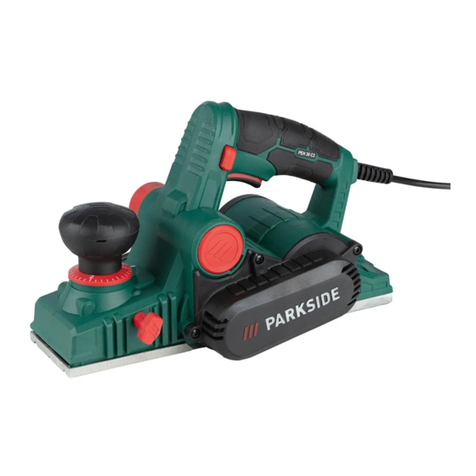
Parkside
Parkside PEH 30 C3 Original instructions
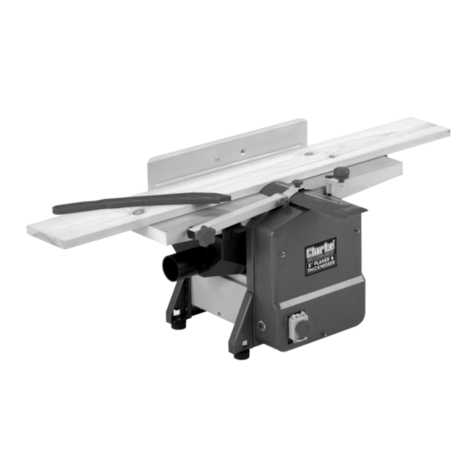
Clarke
Clarke Woodworker CPT600 Operation & maintenance instructions
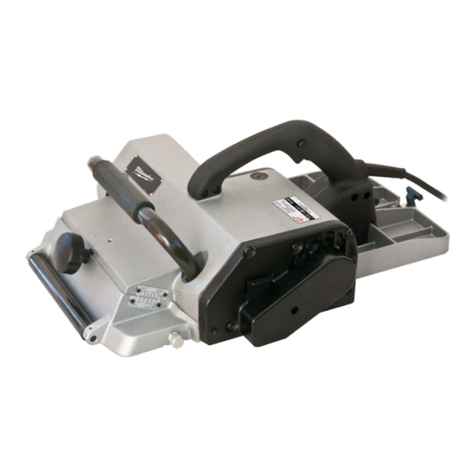
Milwaukee
Milwaukee PR 320 Original instructions

Steel City
Steel City 40300 user manual

Milwaukee
Milwaukee M18 BP Original instructions
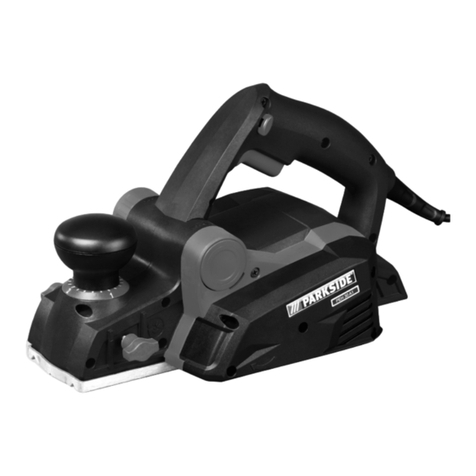
Parkside
Parkside PEH 30 A1 ELECTRIC PLANER Operation manual
